-
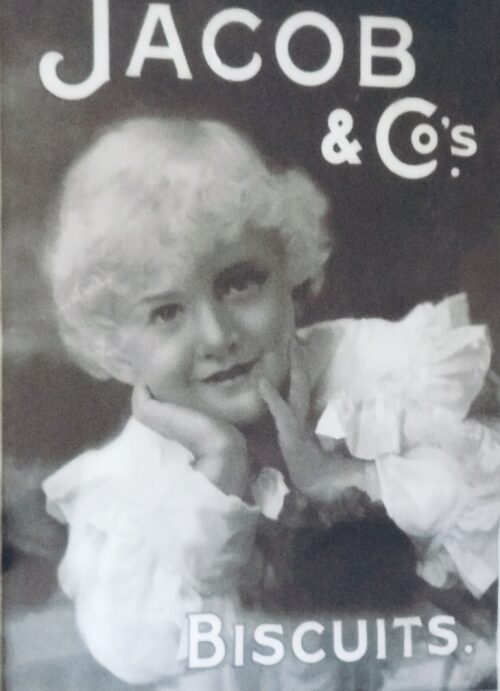
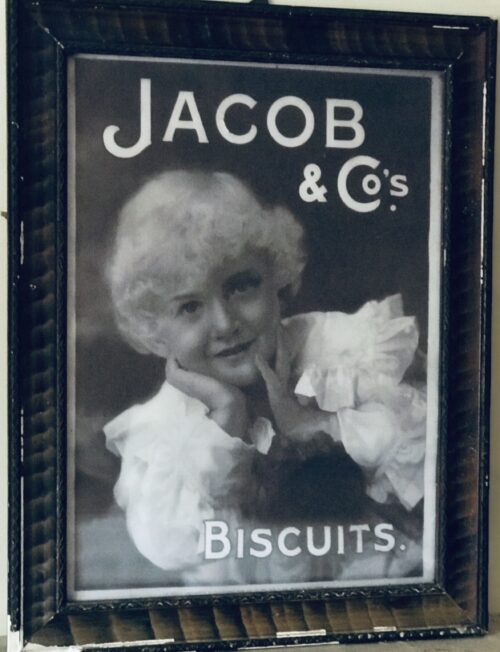 The Jacobs Biscuit Bakery originated in Waterford in 1851,after being founded by William Beale Jacob and his brother Robert.It later moved to Bishop Street in Dublin with a further factory in Peters Row.Jacobs Bishop Street premises was occupied as a strategic location by rebels during the 1916 Easter Rebellion.This charming advert depicting a rather cherubic looking young child dates to the early 1930s. Dublin 57cm x 45cm The biscuit making firm of W. & R. Jacob's were one the largest employers in the Dublin of 1916, and their factory was seized on Easter Monday by perhaps 100 members of the 2nd Battalion of the Dublin Brigade of the Irish Volunteers under Thomas MacDonagh. The factory itself was an enormous and formidable Victorian edifice located on the 'block' enclosed by Bishop St, Bride St, Peter's St and Peter's Row, and between St Patrick's Cathedral and St Stephen's Green. Its seizure helped to complete a loop of building cross the south inner city; the factory had two large towers that could act as observation points, while its location was very close to both Camden St and Patrick St: natural routeways for troops entering the city centre from Portobello Barracks in Rathmines and Wellington Barracks on the South Circular Road. There were only a few staff present in the building when the Volunteers broke into it; a number of smaller outposts were established in the area around the factory. While the garrison saw some fighting early in the week, their principal enemies proved to be boredom and the locals: the factory was surrounded by tenements, and the Volunteers were attacked and abused by residents, many of whom were Jacob's workers themselves. The families of servicemen were also quite hostile, but there may have been another reason for this hostility: Michael O'Hanrahan, who was in Jacob's, expressed his concern that the choice of location might endanger local residents if the British chose to attack. As it happens, the factory was largely by-passed, though it was fired upon intermittently throughout the week by troops in Dublin Castle and elsewhere. MacDonagh surrendered in nearby St Patrick's Park on Sunday 30 April; some of the factory was looted after the Volunteers had left. Three members of the Jacob's garrison were executed. Most of the factory was eventually demolished, though fragments of the ground storey and one of the towers are still visible on Bishop St between the DIT campus on Aungier St and the National Archives of Ireland.
The Jacobs Biscuit Bakery originated in Waterford in 1851,after being founded by William Beale Jacob and his brother Robert.It later moved to Bishop Street in Dublin with a further factory in Peters Row.Jacobs Bishop Street premises was occupied as a strategic location by rebels during the 1916 Easter Rebellion.This charming advert depicting a rather cherubic looking young child dates to the early 1930s. Dublin 57cm x 45cm The biscuit making firm of W. & R. Jacob's were one the largest employers in the Dublin of 1916, and their factory was seized on Easter Monday by perhaps 100 members of the 2nd Battalion of the Dublin Brigade of the Irish Volunteers under Thomas MacDonagh. The factory itself was an enormous and formidable Victorian edifice located on the 'block' enclosed by Bishop St, Bride St, Peter's St and Peter's Row, and between St Patrick's Cathedral and St Stephen's Green. Its seizure helped to complete a loop of building cross the south inner city; the factory had two large towers that could act as observation points, while its location was very close to both Camden St and Patrick St: natural routeways for troops entering the city centre from Portobello Barracks in Rathmines and Wellington Barracks on the South Circular Road. There were only a few staff present in the building when the Volunteers broke into it; a number of smaller outposts were established in the area around the factory. While the garrison saw some fighting early in the week, their principal enemies proved to be boredom and the locals: the factory was surrounded by tenements, and the Volunteers were attacked and abused by residents, many of whom were Jacob's workers themselves. The families of servicemen were also quite hostile, but there may have been another reason for this hostility: Michael O'Hanrahan, who was in Jacob's, expressed his concern that the choice of location might endanger local residents if the British chose to attack. As it happens, the factory was largely by-passed, though it was fired upon intermittently throughout the week by troops in Dublin Castle and elsewhere. MacDonagh surrendered in nearby St Patrick's Park on Sunday 30 April; some of the factory was looted after the Volunteers had left. Three members of the Jacob's garrison were executed. Most of the factory was eventually demolished, though fragments of the ground storey and one of the towers are still visible on Bishop St between the DIT campus on Aungier St and the National Archives of Ireland. -
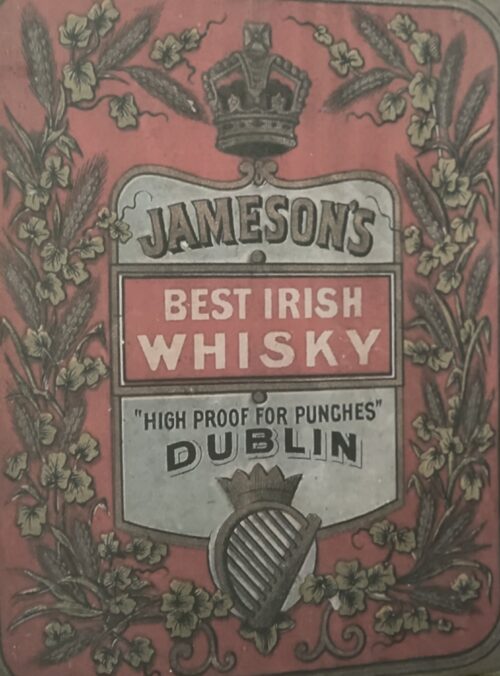
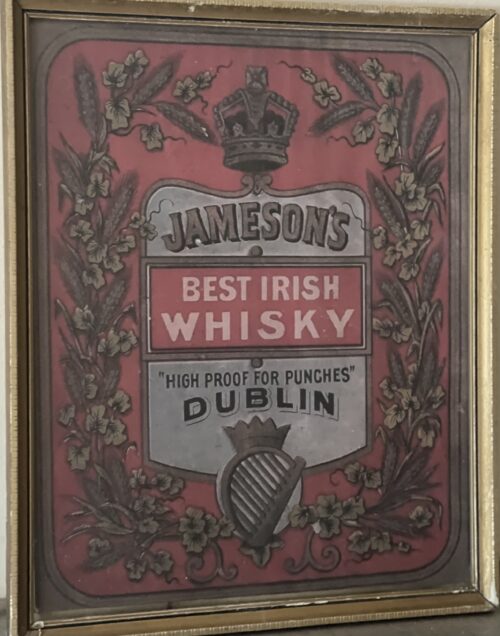 50cm x 40cm Limerick John Jameson was originally a lawyer from Alloa in Scotland before he founded his eponymous distillery in Dublin in 1780.Prevoius to this he had made the wise move of marrying Margaret Haig (1753–1815) in 1768,one of the simple reasons being Margaret was the eldest daughter of John Haig, the famous whisky distiller in Scotland. John and Margaret had eight sons and eight daughters, a family of 16 children. Portraits of the couple by Sir Henry Raeburn are on display in the National Gallery of Ireland. John Jameson joined the Convivial Lodge No. 202, of the Dublin Freemasons on the 24th June 1774 and in 1780, Irish whiskey distillation began at Bow Street. In 1805, he was joined by his son John Jameson II who took over the family business that year and for the next 41 years, John Jameson II built up the business before handing over to his son John Jameson the 3rd in 1851. In 1901, the Company was formally incorporated as John Jameson and Son Ltd. Four of John Jameson’s sons followed his footsteps in distilling in Ireland, John Jameson II (1773 – 1851) at Bow Street, William and James Jameson at Marrowbone Lane in Dublin (where they partnered their Stein relations, calling their business Jameson and Stein, before settling on William Jameson & Co.). The fourth of Jameson's sons, Andrew, who had a small distillery at Enniscorthy, Co. Wexford, was the grandfather of Guglielmo Marconi, inventor of wireless telegraphy. Marconi’s mother was Annie Jameson, Andrew’s daughter. John Jameson’s eldest son, Robert took over his father’s legal business in Alloa. The Jamesons became the most important distilling family in Ireland, despite rivalry between the Bow Street and Marrowbone Lane distilleries. By the turn of the 19th century, it was the second largest producer in Ireland and one of the largest in the world, producing 1,000,000 gallons annually. Dublin at the time was the centre of world whiskey production. It was the second most popular spirit in the world after rum and internationally Jameson had by 1805 become the world's number one whiskey. Today, Jameson is the world's third largest single-distillery whiskey. Historical events, for a time, set the company back. The temperance movement in Ireland had an enormous impact domestically but the two key events that affected Jameson were the Irish War of Independence and subsequent trade war with the British which denied Jameson the export markets of the Commonwealth, and shortly thereafter, the introduction of prohibition in the United States. While Scottish brands could easily slip across the Canada–US border, Jameson was excluded from its biggest market for many years. The introduction of column stills by the Scottish blenders in the mid-19th-century enabled increased production that the Irish, still making labour-intensive single pot still whiskey, could not compete with. There was a legal enquiry somewhere in 1908 to deal with the trade definition of whiskey. The Scottish producers won within some jurisdictions, and blends became recognised in the law of that jurisdiction as whiskey. The Irish in general, and Jameson in particular, continued with the traditional pot still production process for many years.In 1966 John Jameson merged with Cork Distillers and John Powers to form the Irish Distillers Group. In 1976, the Dublin whiskey distilleries of Jameson in Bow Street and in John's Lane were closed following the opening of a New Midleton Distillery by Irish Distillers outside Cork. The Midleton Distillery now produces much of the Irish whiskey sold in Ireland under the Jameson, Midleton, Powers, Redbreast, Spot and Paddy labels. The new facility adjoins the Old Midleton Distillery, the original home of the Paddy label, which is now home to the Jameson Experience Visitor Centre and the Irish Whiskey Academy. The Jameson brand was acquired by the French drinks conglomerate Pernod Ricard in 1988, when it bought Irish Distillers. The old Jameson Distillery in Bow Street near Smithfield in Dublin now serves as a museum which offers tours and tastings. The distillery, which is historical in nature and no longer produces whiskey on site, went through a $12.6 million renovation that was concluded in March 2016, and is now a focal part of Ireland's strategy to raise the number of whiskey tourists, which stood at 600,000 in 2017.Bow Street also now has a fully functioning Maturation Warehouse within its walls since the 2016 renovation. It is here that Jameson 18 Bow Street is finished before being bottled at Cask Strength. In 2008, The Local, an Irish pub in Minneapolis, sold 671 cases of Jameson (22 bottles a day),making it the largest server of Jameson's in the world – a title it maintained for four consecutive years.
50cm x 40cm Limerick John Jameson was originally a lawyer from Alloa in Scotland before he founded his eponymous distillery in Dublin in 1780.Prevoius to this he had made the wise move of marrying Margaret Haig (1753–1815) in 1768,one of the simple reasons being Margaret was the eldest daughter of John Haig, the famous whisky distiller in Scotland. John and Margaret had eight sons and eight daughters, a family of 16 children. Portraits of the couple by Sir Henry Raeburn are on display in the National Gallery of Ireland. John Jameson joined the Convivial Lodge No. 202, of the Dublin Freemasons on the 24th June 1774 and in 1780, Irish whiskey distillation began at Bow Street. In 1805, he was joined by his son John Jameson II who took over the family business that year and for the next 41 years, John Jameson II built up the business before handing over to his son John Jameson the 3rd in 1851. In 1901, the Company was formally incorporated as John Jameson and Son Ltd. Four of John Jameson’s sons followed his footsteps in distilling in Ireland, John Jameson II (1773 – 1851) at Bow Street, William and James Jameson at Marrowbone Lane in Dublin (where they partnered their Stein relations, calling their business Jameson and Stein, before settling on William Jameson & Co.). The fourth of Jameson's sons, Andrew, who had a small distillery at Enniscorthy, Co. Wexford, was the grandfather of Guglielmo Marconi, inventor of wireless telegraphy. Marconi’s mother was Annie Jameson, Andrew’s daughter. John Jameson’s eldest son, Robert took over his father’s legal business in Alloa. The Jamesons became the most important distilling family in Ireland, despite rivalry between the Bow Street and Marrowbone Lane distilleries. By the turn of the 19th century, it was the second largest producer in Ireland and one of the largest in the world, producing 1,000,000 gallons annually. Dublin at the time was the centre of world whiskey production. It was the second most popular spirit in the world after rum and internationally Jameson had by 1805 become the world's number one whiskey. Today, Jameson is the world's third largest single-distillery whiskey. Historical events, for a time, set the company back. The temperance movement in Ireland had an enormous impact domestically but the two key events that affected Jameson were the Irish War of Independence and subsequent trade war with the British which denied Jameson the export markets of the Commonwealth, and shortly thereafter, the introduction of prohibition in the United States. While Scottish brands could easily slip across the Canada–US border, Jameson was excluded from its biggest market for many years. The introduction of column stills by the Scottish blenders in the mid-19th-century enabled increased production that the Irish, still making labour-intensive single pot still whiskey, could not compete with. There was a legal enquiry somewhere in 1908 to deal with the trade definition of whiskey. The Scottish producers won within some jurisdictions, and blends became recognised in the law of that jurisdiction as whiskey. The Irish in general, and Jameson in particular, continued with the traditional pot still production process for many years.In 1966 John Jameson merged with Cork Distillers and John Powers to form the Irish Distillers Group. In 1976, the Dublin whiskey distilleries of Jameson in Bow Street and in John's Lane were closed following the opening of a New Midleton Distillery by Irish Distillers outside Cork. The Midleton Distillery now produces much of the Irish whiskey sold in Ireland under the Jameson, Midleton, Powers, Redbreast, Spot and Paddy labels. The new facility adjoins the Old Midleton Distillery, the original home of the Paddy label, which is now home to the Jameson Experience Visitor Centre and the Irish Whiskey Academy. The Jameson brand was acquired by the French drinks conglomerate Pernod Ricard in 1988, when it bought Irish Distillers. The old Jameson Distillery in Bow Street near Smithfield in Dublin now serves as a museum which offers tours and tastings. The distillery, which is historical in nature and no longer produces whiskey on site, went through a $12.6 million renovation that was concluded in March 2016, and is now a focal part of Ireland's strategy to raise the number of whiskey tourists, which stood at 600,000 in 2017.Bow Street also now has a fully functioning Maturation Warehouse within its walls since the 2016 renovation. It is here that Jameson 18 Bow Street is finished before being bottled at Cask Strength. In 2008, The Local, an Irish pub in Minneapolis, sold 671 cases of Jameson (22 bottles a day),making it the largest server of Jameson's in the world – a title it maintained for four consecutive years. -
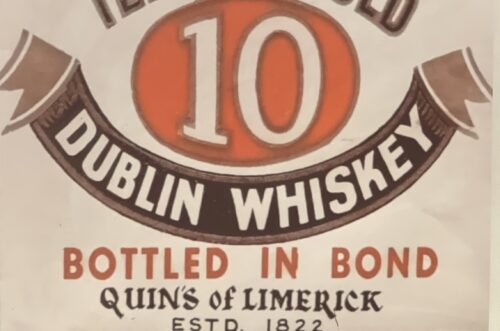
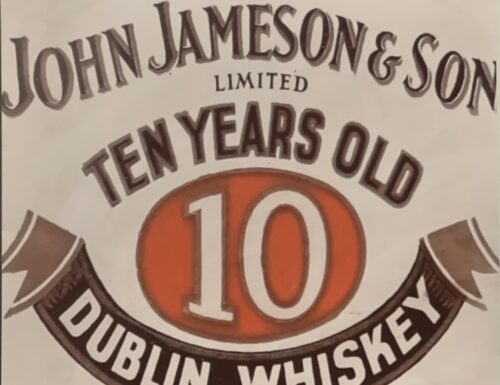 58cm x 58cm Jameson did not bottle our own whiskey until 1963. The first Jameson whiskey bottled at Bow Street was launched as Crested Ten. Back then, Jameson was available in 68 markets worldwide, exporting 15,000 cases annually to the United States. During the 19th century Irish distillers did not bottle and sell their own whiskey. They simply produced the spirit, put it in casks and then sold it on to retailers directly, who would then supply the public as they wished. These spirits merchants were known as bonders, from the practice of holding whiskey “in bond” (i.e. without duties paid on it) in their specialised bonded warehouses. Many pubs also doubled as bonders, which meant they could, supply their patrons with whiskey of which they were assured the provenance. Provenance and dishonesty were the main problem with this system as distilleries had no control over what happened to their whiskey after it left their premises. This lead some of the more unscrupulous proprietors to adulterate the whiskey coming from the cask or lie about how old it was, meaning that a distillery might end up with a bad name for their product through no fault of their own. However, some whiskey bonders of the era were renowned for their dedication to the art of maturing and blending, such that their names and products have today become some of the most important in Irish whiskey.Though beginning life in 1805 as a tea shop and confectionary business, it was in 1887 that the Mitchell family made their mark on Irish spirit history. That was the year they decided to go into the whiskey bonding, following a period as solely wine merchants. The ingenious idea must have seemed quite obvious, they had lots of empty wine and sherry casks so why not send them across the river to Jameson’s Bow Street distillery to be filled with new make single pot still whiskey. Once in the bonded warehouse the casks were given a coloured dash or spot, depending on how long they were due to be aged for, blue for seven years, green for 10, yellow for 12 and red for 15. This led to its renown as “Spot Whiskey” which became hugely popular with the high society of the time and had no lesser proponent than Samuel Beckett, who would order casks to be delivered to his Parisian literary atelier. Thankfully, Mitchell and Son are still going strong, and aged single pot still whiskey from Midleton, in the form of Green and Yellow Spot is widely available. John Jameson was originally a lawyer from Alloa in Scotland before he founded his eponymous distillery in Dublin in 1780.Prevoius to this he had made the wise move of marrying Margaret Haig (1753–1815) in 1768,one of the simple reasons being Margaret was the eldest daughter of John Haig, the famous whisky distiller in Scotland. John and Margaret had eight sons and eight daughters, a family of 16 children. Portraits of the couple by Sir Henry Raeburn are on display in the National Gallery of Ireland. John Jameson joined the Convivial Lodge No. 202, of the Dublin Freemasons on the 24th June 1774 and in 1780, Irish whiskey distillation began at Bow Street. In 1805, he was joined by his son John Jameson II who took over the family business that year and for the next 41 years, John Jameson II built up the business before handing over to his son John Jameson the 3rd in 1851. In 1901, the Company was formally incorporated as John Jameson and Son Ltd. Four of John Jameson’s sons followed his footsteps in distilling in Ireland, John Jameson II (1773 – 1851) at Bow Street, William and James Jameson at Marrowbone Lane in Dublin (where they partnered their Stein relations, calling their business Jameson and Stein, before settling on William Jameson & Co.). The fourth of Jameson's sons, Andrew, who had a small distillery at Enniscorthy, Co. Wexford, was the grandfather of Guglielmo Marconi, inventor of wireless telegraphy. Marconi’s mother was Annie Jameson, Andrew’s daughter. John Jameson’s eldest son, Robert took over his father’s legal business in Alloa. The Jamesons became the most important distilling family in Ireland, despite rivalry between the Bow Street and Marrowbone Lane distilleries. By the turn of the 19th century, it was the second largest producer in Ireland and one of the largest in the world, producing 1,000,000 gallons annually. Dublin at the time was the centre of world whiskey production. It was the second most popular spirit in the world after rum and internationally Jameson had by 1805 become the world's number one whiskey. Today, Jameson is the world's third largest single-distillery whiskey. Historical events, for a time, set the company back. The temperance movement in Ireland had an enormous impact domestically but the two key events that affected Jameson were the Irish War of Independence and subsequent trade war with the British which denied Jameson the export markets of the Commonwealth, and shortly thereafter, the introduction of prohibition in the United States. While Scottish brands could easily slip across the Canada–US border, Jameson was excluded from its biggest market for many years. The introduction of column stills by the Scottish blenders in the mid-19th-century enabled increased production that the Irish, still making labour-intensive single pot still whiskey, could not compete with. There was a legal enquiry somewhere in 1908 to deal with the trade definition of whiskey. The Scottish producers won within some jurisdictions, and blends became recognised in the law of that jurisdiction as whiskey. The Irish in general, and Jameson in particular, continued with the traditional pot still production process for many years.In 1966 John Jameson merged with Cork Distillers and John Powers to form the Irish Distillers Group. In 1976, the Dublin whiskey distilleries of Jameson in Bow Street and in John's Lane were closed following the opening of a New Midleton Distillery by Irish Distillers outside Cork. The Midleton Distillery now produces much of the Irish whiskey sold in Ireland under the Jameson, Midleton, Powers, Redbreast, Spot and Paddy labels. The new facility adjoins the Old Midleton Distillery, the original home of the Paddy label, which is now home to the Jameson Experience Visitor Centre and the Irish Whiskey Academy. The Jameson brand was acquired by the French drinks conglomerate Pernod Ricard in 1988, when it bought Irish Distillers. The old Jameson Distillery in Bow Street near Smithfield in Dublin now serves as a museum which offers tours and tastings. The distillery, which is historical in nature and no longer produces whiskey on site, went through a $12.6 million renovation that was concluded in March 2016, and is now a focal part of Ireland's strategy to raise the number of whiskey tourists, which stood at 600,000 in 2017.Bow Street also now has a fully functioning Maturation Warehouse within its walls since the 2016 renovation. It is here that Jameson 18 Bow Street is finished before being bottled at Cask Strength. In 2008, The Local, an Irish pub in Minneapolis, sold 671 cases of Jameson (22 bottles a day),making it the largest server of Jameson's in the world – a title it
58cm x 58cm Jameson did not bottle our own whiskey until 1963. The first Jameson whiskey bottled at Bow Street was launched as Crested Ten. Back then, Jameson was available in 68 markets worldwide, exporting 15,000 cases annually to the United States. During the 19th century Irish distillers did not bottle and sell their own whiskey. They simply produced the spirit, put it in casks and then sold it on to retailers directly, who would then supply the public as they wished. These spirits merchants were known as bonders, from the practice of holding whiskey “in bond” (i.e. without duties paid on it) in their specialised bonded warehouses. Many pubs also doubled as bonders, which meant they could, supply their patrons with whiskey of which they were assured the provenance. Provenance and dishonesty were the main problem with this system as distilleries had no control over what happened to their whiskey after it left their premises. This lead some of the more unscrupulous proprietors to adulterate the whiskey coming from the cask or lie about how old it was, meaning that a distillery might end up with a bad name for their product through no fault of their own. However, some whiskey bonders of the era were renowned for their dedication to the art of maturing and blending, such that their names and products have today become some of the most important in Irish whiskey.Though beginning life in 1805 as a tea shop and confectionary business, it was in 1887 that the Mitchell family made their mark on Irish spirit history. That was the year they decided to go into the whiskey bonding, following a period as solely wine merchants. The ingenious idea must have seemed quite obvious, they had lots of empty wine and sherry casks so why not send them across the river to Jameson’s Bow Street distillery to be filled with new make single pot still whiskey. Once in the bonded warehouse the casks were given a coloured dash or spot, depending on how long they were due to be aged for, blue for seven years, green for 10, yellow for 12 and red for 15. This led to its renown as “Spot Whiskey” which became hugely popular with the high society of the time and had no lesser proponent than Samuel Beckett, who would order casks to be delivered to his Parisian literary atelier. Thankfully, Mitchell and Son are still going strong, and aged single pot still whiskey from Midleton, in the form of Green and Yellow Spot is widely available. John Jameson was originally a lawyer from Alloa in Scotland before he founded his eponymous distillery in Dublin in 1780.Prevoius to this he had made the wise move of marrying Margaret Haig (1753–1815) in 1768,one of the simple reasons being Margaret was the eldest daughter of John Haig, the famous whisky distiller in Scotland. John and Margaret had eight sons and eight daughters, a family of 16 children. Portraits of the couple by Sir Henry Raeburn are on display in the National Gallery of Ireland. John Jameson joined the Convivial Lodge No. 202, of the Dublin Freemasons on the 24th June 1774 and in 1780, Irish whiskey distillation began at Bow Street. In 1805, he was joined by his son John Jameson II who took over the family business that year and for the next 41 years, John Jameson II built up the business before handing over to his son John Jameson the 3rd in 1851. In 1901, the Company was formally incorporated as John Jameson and Son Ltd. Four of John Jameson’s sons followed his footsteps in distilling in Ireland, John Jameson II (1773 – 1851) at Bow Street, William and James Jameson at Marrowbone Lane in Dublin (where they partnered their Stein relations, calling their business Jameson and Stein, before settling on William Jameson & Co.). The fourth of Jameson's sons, Andrew, who had a small distillery at Enniscorthy, Co. Wexford, was the grandfather of Guglielmo Marconi, inventor of wireless telegraphy. Marconi’s mother was Annie Jameson, Andrew’s daughter. John Jameson’s eldest son, Robert took over his father’s legal business in Alloa. The Jamesons became the most important distilling family in Ireland, despite rivalry between the Bow Street and Marrowbone Lane distilleries. By the turn of the 19th century, it was the second largest producer in Ireland and one of the largest in the world, producing 1,000,000 gallons annually. Dublin at the time was the centre of world whiskey production. It was the second most popular spirit in the world after rum and internationally Jameson had by 1805 become the world's number one whiskey. Today, Jameson is the world's third largest single-distillery whiskey. Historical events, for a time, set the company back. The temperance movement in Ireland had an enormous impact domestically but the two key events that affected Jameson were the Irish War of Independence and subsequent trade war with the British which denied Jameson the export markets of the Commonwealth, and shortly thereafter, the introduction of prohibition in the United States. While Scottish brands could easily slip across the Canada–US border, Jameson was excluded from its biggest market for many years. The introduction of column stills by the Scottish blenders in the mid-19th-century enabled increased production that the Irish, still making labour-intensive single pot still whiskey, could not compete with. There was a legal enquiry somewhere in 1908 to deal with the trade definition of whiskey. The Scottish producers won within some jurisdictions, and blends became recognised in the law of that jurisdiction as whiskey. The Irish in general, and Jameson in particular, continued with the traditional pot still production process for many years.In 1966 John Jameson merged with Cork Distillers and John Powers to form the Irish Distillers Group. In 1976, the Dublin whiskey distilleries of Jameson in Bow Street and in John's Lane were closed following the opening of a New Midleton Distillery by Irish Distillers outside Cork. The Midleton Distillery now produces much of the Irish whiskey sold in Ireland under the Jameson, Midleton, Powers, Redbreast, Spot and Paddy labels. The new facility adjoins the Old Midleton Distillery, the original home of the Paddy label, which is now home to the Jameson Experience Visitor Centre and the Irish Whiskey Academy. The Jameson brand was acquired by the French drinks conglomerate Pernod Ricard in 1988, when it bought Irish Distillers. The old Jameson Distillery in Bow Street near Smithfield in Dublin now serves as a museum which offers tours and tastings. The distillery, which is historical in nature and no longer produces whiskey on site, went through a $12.6 million renovation that was concluded in March 2016, and is now a focal part of Ireland's strategy to raise the number of whiskey tourists, which stood at 600,000 in 2017.Bow Street also now has a fully functioning Maturation Warehouse within its walls since the 2016 renovation. It is here that Jameson 18 Bow Street is finished before being bottled at Cask Strength. In 2008, The Local, an Irish pub in Minneapolis, sold 671 cases of Jameson (22 bottles a day),making it the largest server of Jameson's in the world – a title it -

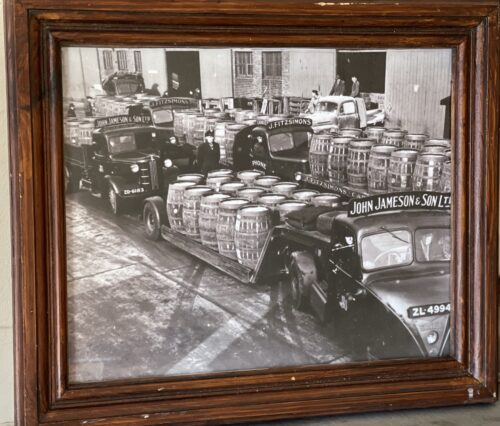 46cm x 37cm. John Jameson was originally a lawyer from Alloa in Scotland before he founded his eponymous distillery in Dublin in 1780.Prevoius to this he had made the wise move of marrying Margaret Haig (1753–1815) in 1768,one of the simple reasons being Margaret was the eldest daughter of John Haig, the famous whisky distiller in Scotland. John and Margaret had eight sons and eight daughters, a family of 16 children. Portraits of the couple by Sir Henry Raeburn are on display in the National Gallery of Ireland. John Jameson joined the Convivial Lodge No. 202, of the Dublin Freemasons on the 24th June 1774 and in 1780, Irish whiskey distillation began at Bow Street. In 1805, he was joined by his son John Jameson II who took over the family business that year and for the next 41 years, John Jameson II built up the business before handing over to his son John Jameson the 3rd in 1851. In 1901, the Company was formally incorporated as John Jameson and Son Ltd. Four of John Jameson’s sons followed his footsteps in distilling in Ireland, John Jameson II (1773 – 1851) at Bow Street, William and James Jameson at Marrowbone Lane in Dublin (where they partnered their Stein relations, calling their business Jameson and Stein, before settling on William Jameson & Co.). The fourth of Jameson's sons, Andrew, who had a small distillery at Enniscorthy, Co. Wexford, was the grandfather of Guglielmo Marconi, inventor of wireless telegraphy. Marconi’s mother was Annie Jameson, Andrew’s daughter. John Jameson’s eldest son, Robert took over his father’s legal business in Alloa. The Jamesons became the most important distilling family in Ireland, despite rivalry between the Bow Street and Marrowbone Lane distilleries. By the turn of the 19th century, it was the second largest producer in Ireland and one of the largest in the world, producing 1,000,000 gallons annually. Dublin at the time was the centre of world whiskey production. It was the second most popular spirit in the world after rum and internationally Jameson had by 1805 become the world's number one whiskey. Today, Jameson is the world's third largest single-distillery whiskey. Historical events, for a time, set the company back. The temperance movement in Ireland had an enormous impact domestically but the two key events that affected Jameson were the Irish War of Independence and subsequent trade war with the British which denied Jameson the export markets of the Commonwealth, and shortly thereafter, the introduction of prohibition in the United States. While Scottish brands could easily slip across the Canada–US border, Jameson was excluded from its biggest market for many years. The introduction of column stills by the Scottish blenders in the mid-19th-century enabled increased production that the Irish, still making labour-intensive single pot still whiskey, could not compete with. There was a legal enquiry somewhere in 1908 to deal with the trade definition of whiskey. The Scottish producers won within some jurisdictions, and blends became recognised in the law of that jurisdiction as whiskey. The Irish in general, and Jameson in particular, continued with the traditional pot still production process for many years.In 1966 John Jameson merged with Cork Distillers and John Powers to form the Irish Distillers Group. In 1976, the Dublin whiskey distilleries of Jameson in Bow Street and in John's Lane were closed following the opening of a New Midleton Distillery by Irish Distillers outside Cork. The Midleton Distillery now produces much of the Irish whiskey sold in Ireland under the Jameson, Midleton, Powers, Redbreast, Spot and Paddy labels. The new facility adjoins the Old Midleton Distillery, the original home of the Paddy label, which is now home to the Jameson Experience Visitor Centre and the Irish Whiskey Academy. The Jameson brand was acquired by the French drinks conglomerate Pernod Ricard in 1988, when it bought Irish Distillers. The old Jameson Distillery in Bow Street near Smithfield in Dublin now serves as a museum which offers tours and tastings. The distillery, which is historical in nature and no longer produces whiskey on site, went through a $12.6 million renovation that was concluded in March 2016, and is now a focal part of Ireland's strategy to raise the number of whiskey tourists, which stood at 600,000 in 2017.Bow Street also now has a fully functioning Maturation Warehouse within its walls since the 2016 renovation. It is here that Jameson 18 Bow Street is finished before being bottled at Cask Strength. In 2008, The Local, an Irish pub in Minneapolis, sold 671 cases of Jameson (22 bottles a day),making it the largest server of Jameson's in the world – a title it maintained for four consecutive years.
46cm x 37cm. John Jameson was originally a lawyer from Alloa in Scotland before he founded his eponymous distillery in Dublin in 1780.Prevoius to this he had made the wise move of marrying Margaret Haig (1753–1815) in 1768,one of the simple reasons being Margaret was the eldest daughter of John Haig, the famous whisky distiller in Scotland. John and Margaret had eight sons and eight daughters, a family of 16 children. Portraits of the couple by Sir Henry Raeburn are on display in the National Gallery of Ireland. John Jameson joined the Convivial Lodge No. 202, of the Dublin Freemasons on the 24th June 1774 and in 1780, Irish whiskey distillation began at Bow Street. In 1805, he was joined by his son John Jameson II who took over the family business that year and for the next 41 years, John Jameson II built up the business before handing over to his son John Jameson the 3rd in 1851. In 1901, the Company was formally incorporated as John Jameson and Son Ltd. Four of John Jameson’s sons followed his footsteps in distilling in Ireland, John Jameson II (1773 – 1851) at Bow Street, William and James Jameson at Marrowbone Lane in Dublin (where they partnered their Stein relations, calling their business Jameson and Stein, before settling on William Jameson & Co.). The fourth of Jameson's sons, Andrew, who had a small distillery at Enniscorthy, Co. Wexford, was the grandfather of Guglielmo Marconi, inventor of wireless telegraphy. Marconi’s mother was Annie Jameson, Andrew’s daughter. John Jameson’s eldest son, Robert took over his father’s legal business in Alloa. The Jamesons became the most important distilling family in Ireland, despite rivalry between the Bow Street and Marrowbone Lane distilleries. By the turn of the 19th century, it was the second largest producer in Ireland and one of the largest in the world, producing 1,000,000 gallons annually. Dublin at the time was the centre of world whiskey production. It was the second most popular spirit in the world after rum and internationally Jameson had by 1805 become the world's number one whiskey. Today, Jameson is the world's third largest single-distillery whiskey. Historical events, for a time, set the company back. The temperance movement in Ireland had an enormous impact domestically but the two key events that affected Jameson were the Irish War of Independence and subsequent trade war with the British which denied Jameson the export markets of the Commonwealth, and shortly thereafter, the introduction of prohibition in the United States. While Scottish brands could easily slip across the Canada–US border, Jameson was excluded from its biggest market for many years. The introduction of column stills by the Scottish blenders in the mid-19th-century enabled increased production that the Irish, still making labour-intensive single pot still whiskey, could not compete with. There was a legal enquiry somewhere in 1908 to deal with the trade definition of whiskey. The Scottish producers won within some jurisdictions, and blends became recognised in the law of that jurisdiction as whiskey. The Irish in general, and Jameson in particular, continued with the traditional pot still production process for many years.In 1966 John Jameson merged with Cork Distillers and John Powers to form the Irish Distillers Group. In 1976, the Dublin whiskey distilleries of Jameson in Bow Street and in John's Lane were closed following the opening of a New Midleton Distillery by Irish Distillers outside Cork. The Midleton Distillery now produces much of the Irish whiskey sold in Ireland under the Jameson, Midleton, Powers, Redbreast, Spot and Paddy labels. The new facility adjoins the Old Midleton Distillery, the original home of the Paddy label, which is now home to the Jameson Experience Visitor Centre and the Irish Whiskey Academy. The Jameson brand was acquired by the French drinks conglomerate Pernod Ricard in 1988, when it bought Irish Distillers. The old Jameson Distillery in Bow Street near Smithfield in Dublin now serves as a museum which offers tours and tastings. The distillery, which is historical in nature and no longer produces whiskey on site, went through a $12.6 million renovation that was concluded in March 2016, and is now a focal part of Ireland's strategy to raise the number of whiskey tourists, which stood at 600,000 in 2017.Bow Street also now has a fully functioning Maturation Warehouse within its walls since the 2016 renovation. It is here that Jameson 18 Bow Street is finished before being bottled at Cask Strength. In 2008, The Local, an Irish pub in Minneapolis, sold 671 cases of Jameson (22 bottles a day),making it the largest server of Jameson's in the world – a title it maintained for four consecutive years. -
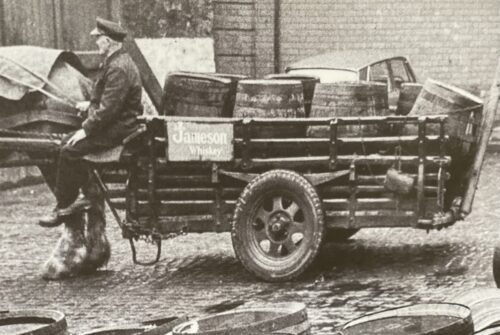
 46cm x 37cm. John Jameson was originally a lawyer from Alloa in Scotland before he founded his eponymous distillery in Dublin in 1780.Prevoius to this he had made the wise move of marrying Margaret Haig (1753–1815) in 1768,one of the simple reasons being Margaret was the eldest daughter of John Haig, the famous whisky distiller in Scotland. John and Margaret had eight sons and eight daughters, a family of 16 children. Portraits of the couple by Sir Henry Raeburn are on display in the National Gallery of Ireland. John Jameson joined the Convivial Lodge No. 202, of the Dublin Freemasons on the 24th June 1774 and in 1780, Irish whiskey distillation began at Bow Street. In 1805, he was joined by his son John Jameson II who took over the family business that year and for the next 41 years, John Jameson II built up the business before handing over to his son John Jameson the 3rd in 1851. In 1901, the Company was formally incorporated as John Jameson and Son Ltd. Four of John Jameson’s sons followed his footsteps in distilling in Ireland, John Jameson II (1773 – 1851) at Bow Street, William and James Jameson at Marrowbone Lane in Dublin (where they partnered their Stein relations, calling their business Jameson and Stein, before settling on William Jameson & Co.). The fourth of Jameson's sons, Andrew, who had a small distillery at Enniscorthy, Co. Wexford, was the grandfather of Guglielmo Marconi, inventor of wireless telegraphy. Marconi’s mother was Annie Jameson, Andrew’s daughter. John Jameson’s eldest son, Robert took over his father’s legal business in Alloa. The Jamesons became the most important distilling family in Ireland, despite rivalry between the Bow Street and Marrowbone Lane distilleries. By the turn of the 19th century, it was the second largest producer in Ireland and one of the largest in the world, producing 1,000,000 gallons annually. Dublin at the time was the centre of world whiskey production. It was the second most popular spirit in the world after rum and internationally Jameson had by 1805 become the world's number one whiskey. Today, Jameson is the world's third largest single-distillery whiskey. Historical events, for a time, set the company back. The temperance movement in Ireland had an enormous impact domestically but the two key events that affected Jameson were the Irish War of Independence and subsequent trade war with the British which denied Jameson the export markets of the Commonwealth, and shortly thereafter, the introduction of prohibition in the United States. While Scottish brands could easily slip across the Canada–US border, Jameson was excluded from its biggest market for many years. The introduction of column stills by the Scottish blenders in the mid-19th-century enabled increased production that the Irish, still making labour-intensive single pot still whiskey, could not compete with. There was a legal enquiry somewhere in 1908 to deal with the trade definition of whiskey. The Scottish producers won within some jurisdictions, and blends became recognised in the law of that jurisdiction as whiskey. The Irish in general, and Jameson in particular, continued with the traditional pot still production process for many years.In 1966 John Jameson merged with Cork Distillers and John Powers to form the Irish Distillers Group. In 1976, the Dublin whiskey distilleries of Jameson in Bow Street and in John's Lane were closed following the opening of a New Midleton Distillery by Irish Distillers outside Cork. The Midleton Distillery now produces much of the Irish whiskey sold in Ireland under the Jameson, Midleton, Powers, Redbreast, Spot and Paddy labels. The new facility adjoins the Old Midleton Distillery, the original home of the Paddy label, which is now home to the Jameson Experience Visitor Centre and the Irish Whiskey Academy. The Jameson brand was acquired by the French drinks conglomerate Pernod Ricard in 1988, when it bought Irish Distillers. The old Jameson Distillery in Bow Street near Smithfield in Dublin now serves as a museum which offers tours and tastings. The distillery, which is historical in nature and no longer produces whiskey on site, went through a $12.6 million renovation that was concluded in March 2016, and is now a focal part of Ireland's strategy to raise the number of whiskey tourists, which stood at 600,000 in 2017.Bow Street also now has a fully functioning Maturation Warehouse within its walls since the 2016 renovation. It is here that Jameson 18 Bow Street is finished before being bottled at Cask Strength. In 2008, The Local, an Irish pub in Minneapolis, sold 671 cases of Jameson (22 bottles a day),making it the largest server of Jameson's in the world – a title it maintained for four consecutive years.
46cm x 37cm. John Jameson was originally a lawyer from Alloa in Scotland before he founded his eponymous distillery in Dublin in 1780.Prevoius to this he had made the wise move of marrying Margaret Haig (1753–1815) in 1768,one of the simple reasons being Margaret was the eldest daughter of John Haig, the famous whisky distiller in Scotland. John and Margaret had eight sons and eight daughters, a family of 16 children. Portraits of the couple by Sir Henry Raeburn are on display in the National Gallery of Ireland. John Jameson joined the Convivial Lodge No. 202, of the Dublin Freemasons on the 24th June 1774 and in 1780, Irish whiskey distillation began at Bow Street. In 1805, he was joined by his son John Jameson II who took over the family business that year and for the next 41 years, John Jameson II built up the business before handing over to his son John Jameson the 3rd in 1851. In 1901, the Company was formally incorporated as John Jameson and Son Ltd. Four of John Jameson’s sons followed his footsteps in distilling in Ireland, John Jameson II (1773 – 1851) at Bow Street, William and James Jameson at Marrowbone Lane in Dublin (where they partnered their Stein relations, calling their business Jameson and Stein, before settling on William Jameson & Co.). The fourth of Jameson's sons, Andrew, who had a small distillery at Enniscorthy, Co. Wexford, was the grandfather of Guglielmo Marconi, inventor of wireless telegraphy. Marconi’s mother was Annie Jameson, Andrew’s daughter. John Jameson’s eldest son, Robert took over his father’s legal business in Alloa. The Jamesons became the most important distilling family in Ireland, despite rivalry between the Bow Street and Marrowbone Lane distilleries. By the turn of the 19th century, it was the second largest producer in Ireland and one of the largest in the world, producing 1,000,000 gallons annually. Dublin at the time was the centre of world whiskey production. It was the second most popular spirit in the world after rum and internationally Jameson had by 1805 become the world's number one whiskey. Today, Jameson is the world's third largest single-distillery whiskey. Historical events, for a time, set the company back. The temperance movement in Ireland had an enormous impact domestically but the two key events that affected Jameson were the Irish War of Independence and subsequent trade war with the British which denied Jameson the export markets of the Commonwealth, and shortly thereafter, the introduction of prohibition in the United States. While Scottish brands could easily slip across the Canada–US border, Jameson was excluded from its biggest market for many years. The introduction of column stills by the Scottish blenders in the mid-19th-century enabled increased production that the Irish, still making labour-intensive single pot still whiskey, could not compete with. There was a legal enquiry somewhere in 1908 to deal with the trade definition of whiskey. The Scottish producers won within some jurisdictions, and blends became recognised in the law of that jurisdiction as whiskey. The Irish in general, and Jameson in particular, continued with the traditional pot still production process for many years.In 1966 John Jameson merged with Cork Distillers and John Powers to form the Irish Distillers Group. In 1976, the Dublin whiskey distilleries of Jameson in Bow Street and in John's Lane were closed following the opening of a New Midleton Distillery by Irish Distillers outside Cork. The Midleton Distillery now produces much of the Irish whiskey sold in Ireland under the Jameson, Midleton, Powers, Redbreast, Spot and Paddy labels. The new facility adjoins the Old Midleton Distillery, the original home of the Paddy label, which is now home to the Jameson Experience Visitor Centre and the Irish Whiskey Academy. The Jameson brand was acquired by the French drinks conglomerate Pernod Ricard in 1988, when it bought Irish Distillers. The old Jameson Distillery in Bow Street near Smithfield in Dublin now serves as a museum which offers tours and tastings. The distillery, which is historical in nature and no longer produces whiskey on site, went through a $12.6 million renovation that was concluded in March 2016, and is now a focal part of Ireland's strategy to raise the number of whiskey tourists, which stood at 600,000 in 2017.Bow Street also now has a fully functioning Maturation Warehouse within its walls since the 2016 renovation. It is here that Jameson 18 Bow Street is finished before being bottled at Cask Strength. In 2008, The Local, an Irish pub in Minneapolis, sold 671 cases of Jameson (22 bottles a day),making it the largest server of Jameson's in the world – a title it maintained for four consecutive years. -

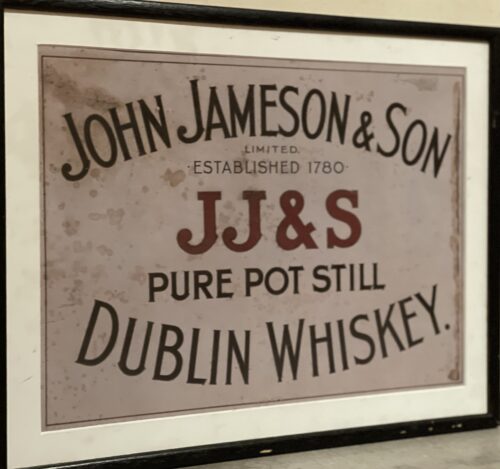 47cm x 34cm John Jameson was originally a lawyer from Alloa in Scotland before he founded his eponymous distillery in Dublin in 1780.Prevoius to this he had made the wise move of marrying Margaret Haig (1753–1815) in 1768,one of the simple reasons being Margaret was the eldest daughter of John Haig, the famous whisky distiller in Scotland. John and Margaret had eight sons and eight daughters, a family of 16 children. Portraits of the couple by Sir Henry Raeburn are on display in the National Gallery of Ireland. John Jameson joined the Convivial Lodge No. 202, of the Dublin Freemasons on the 24th June 1774 and in 1780, Irish whiskey distillation began at Bow Street. In 1805, he was joined by his son John Jameson II who took over the family business that year and for the next 41 years, John Jameson II built up the business before handing over to his son John Jameson the 3rd in 1851. In 1901, the Company was formally incorporated as John Jameson and Son Ltd. Four of John Jameson’s sons followed his footsteps in distilling in Ireland, John Jameson II (1773 – 1851) at Bow Street, William and James Jameson at Marrowbone Lane in Dublin (where they partnered their Stein relations, calling their business Jameson and Stein, before settling on William Jameson & Co.). The fourth of Jameson's sons, Andrew, who had a small distillery at Enniscorthy, Co. Wexford, was the grandfather of Guglielmo Marconi, inventor of wireless telegraphy. Marconi’s mother was Annie Jameson, Andrew’s daughter. John Jameson’s eldest son, Robert took over his father’s legal business in Alloa. The Jamesons became the most important distilling family in Ireland, despite rivalry between the Bow Street and Marrowbone Lane distilleries. By the turn of the 19th century, it was the second largest producer in Ireland and one of the largest in the world, producing 1,000,000 gallons annually. Dublin at the time was the centre of world whiskey production. It was the second most popular spirit in the world after rum and internationally Jameson had by 1805 become the world's number one whiskey. Today, Jameson is the world's third largest single-distillery whiskey. Historical events, for a time, set the company back. The temperance movement in Ireland had an enormous impact domestically but the two key events that affected Jameson were the Irish War of Independence and subsequent trade war with the British which denied Jameson the export markets of the Commonwealth, and shortly thereafter, the introduction of prohibition in the United States. While Scottish brands could easily slip across the Canada–US border, Jameson was excluded from its biggest market for many years. The introduction of column stills by the Scottish blenders in the mid-19th-century enabled increased production that the Irish, still making labour-intensive single pot still whiskey, could not compete with. There was a legal enquiry somewhere in 1908 to deal with the trade definition of whiskey. The Scottish producers won within some jurisdictions, and blends became recognised in the law of that jurisdiction as whiskey. The Irish in general, and Jameson in particular, continued with the traditional pot still production process for many years.In 1966 John Jameson merged with Cork Distillers and John Powers to form the Irish Distillers Group. In 1976, the Dublin whiskey distilleries of Jameson in Bow Street and in John's Lane were closed following the opening of a New Midleton Distillery by Irish Distillers outside Cork. The Midleton Distillery now produces much of the Irish whiskey sold in Ireland under the Jameson, Midleton, Powers, Redbreast, Spot and Paddy labels. The new facility adjoins the Old Midleton Distillery, the original home of the Paddy label, which is now home to the Jameson Experience Visitor Centre and the Irish Whiskey Academy. The Jameson brand was acquired by the French drinks conglomerate Pernod Ricard in 1988, when it bought Irish Distillers. The old Jameson Distillery in Bow Street near Smithfield in Dublin now serves as a museum which offers tours and tastings. The distillery, which is historical in nature and no longer produces whiskey on site, went through a $12.6 million renovation that was concluded in March 2016, and is now a focal part of Ireland's strategy to raise the number of whiskey tourists, which stood at 600,000 in 2017.Bow Street also now has a fully functioning Maturation Warehouse within its walls since the 2016 renovation. It is here that Jameson 18 Bow Street is finished before being bottled at Cask Strength. In 2008, The Local, an Irish pub in Minneapolis, sold 671 cases of Jameson (22 bottles a day),making it the largest server of Jameson's in the world – a title it
47cm x 34cm John Jameson was originally a lawyer from Alloa in Scotland before he founded his eponymous distillery in Dublin in 1780.Prevoius to this he had made the wise move of marrying Margaret Haig (1753–1815) in 1768,one of the simple reasons being Margaret was the eldest daughter of John Haig, the famous whisky distiller in Scotland. John and Margaret had eight sons and eight daughters, a family of 16 children. Portraits of the couple by Sir Henry Raeburn are on display in the National Gallery of Ireland. John Jameson joined the Convivial Lodge No. 202, of the Dublin Freemasons on the 24th June 1774 and in 1780, Irish whiskey distillation began at Bow Street. In 1805, he was joined by his son John Jameson II who took over the family business that year and for the next 41 years, John Jameson II built up the business before handing over to his son John Jameson the 3rd in 1851. In 1901, the Company was formally incorporated as John Jameson and Son Ltd. Four of John Jameson’s sons followed his footsteps in distilling in Ireland, John Jameson II (1773 – 1851) at Bow Street, William and James Jameson at Marrowbone Lane in Dublin (where they partnered their Stein relations, calling their business Jameson and Stein, before settling on William Jameson & Co.). The fourth of Jameson's sons, Andrew, who had a small distillery at Enniscorthy, Co. Wexford, was the grandfather of Guglielmo Marconi, inventor of wireless telegraphy. Marconi’s mother was Annie Jameson, Andrew’s daughter. John Jameson’s eldest son, Robert took over his father’s legal business in Alloa. The Jamesons became the most important distilling family in Ireland, despite rivalry between the Bow Street and Marrowbone Lane distilleries. By the turn of the 19th century, it was the second largest producer in Ireland and one of the largest in the world, producing 1,000,000 gallons annually. Dublin at the time was the centre of world whiskey production. It was the second most popular spirit in the world after rum and internationally Jameson had by 1805 become the world's number one whiskey. Today, Jameson is the world's third largest single-distillery whiskey. Historical events, for a time, set the company back. The temperance movement in Ireland had an enormous impact domestically but the two key events that affected Jameson were the Irish War of Independence and subsequent trade war with the British which denied Jameson the export markets of the Commonwealth, and shortly thereafter, the introduction of prohibition in the United States. While Scottish brands could easily slip across the Canada–US border, Jameson was excluded from its biggest market for many years. The introduction of column stills by the Scottish blenders in the mid-19th-century enabled increased production that the Irish, still making labour-intensive single pot still whiskey, could not compete with. There was a legal enquiry somewhere in 1908 to deal with the trade definition of whiskey. The Scottish producers won within some jurisdictions, and blends became recognised in the law of that jurisdiction as whiskey. The Irish in general, and Jameson in particular, continued with the traditional pot still production process for many years.In 1966 John Jameson merged with Cork Distillers and John Powers to form the Irish Distillers Group. In 1976, the Dublin whiskey distilleries of Jameson in Bow Street and in John's Lane were closed following the opening of a New Midleton Distillery by Irish Distillers outside Cork. The Midleton Distillery now produces much of the Irish whiskey sold in Ireland under the Jameson, Midleton, Powers, Redbreast, Spot and Paddy labels. The new facility adjoins the Old Midleton Distillery, the original home of the Paddy label, which is now home to the Jameson Experience Visitor Centre and the Irish Whiskey Academy. The Jameson brand was acquired by the French drinks conglomerate Pernod Ricard in 1988, when it bought Irish Distillers. The old Jameson Distillery in Bow Street near Smithfield in Dublin now serves as a museum which offers tours and tastings. The distillery, which is historical in nature and no longer produces whiskey on site, went through a $12.6 million renovation that was concluded in March 2016, and is now a focal part of Ireland's strategy to raise the number of whiskey tourists, which stood at 600,000 in 2017.Bow Street also now has a fully functioning Maturation Warehouse within its walls since the 2016 renovation. It is here that Jameson 18 Bow Street is finished before being bottled at Cask Strength. In 2008, The Local, an Irish pub in Minneapolis, sold 671 cases of Jameson (22 bottles a day),making it the largest server of Jameson's in the world – a title it -
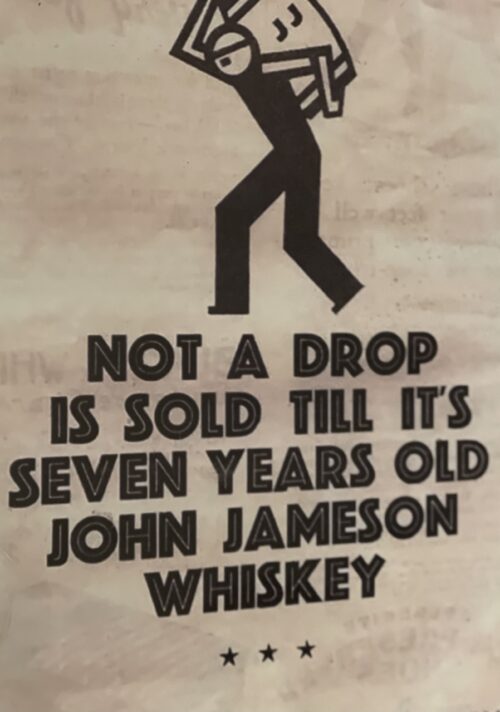
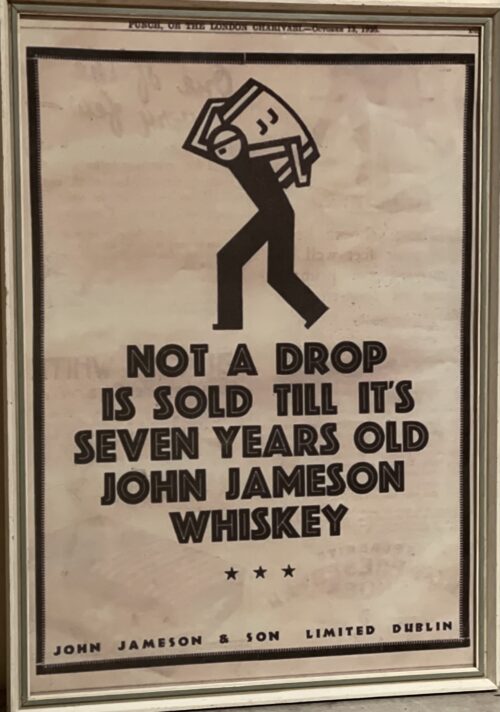 42cm x 31cm Vintage John Jameson Punch Magazine Advert from 1928 featuring the iconic Barrelman .WHY A BARRELMAN? In 1930 John Jameson made a barrelman mascot for aviator Sir C. Kingford-Smith. On June 24th 1930, the mascot took pride of place in the 'Southern Cross' plane that flew from Portmarnock, Ireland on the transatlantic odyssey to America. Since the making of this first lucky mascot, Jameson has revived the icon of the Barrelman, placing him front and centre on their communications.
42cm x 31cm Vintage John Jameson Punch Magazine Advert from 1928 featuring the iconic Barrelman .WHY A BARRELMAN? In 1930 John Jameson made a barrelman mascot for aviator Sir C. Kingford-Smith. On June 24th 1930, the mascot took pride of place in the 'Southern Cross' plane that flew from Portmarnock, Ireland on the transatlantic odyssey to America. Since the making of this first lucky mascot, Jameson has revived the icon of the Barrelman, placing him front and centre on their communications.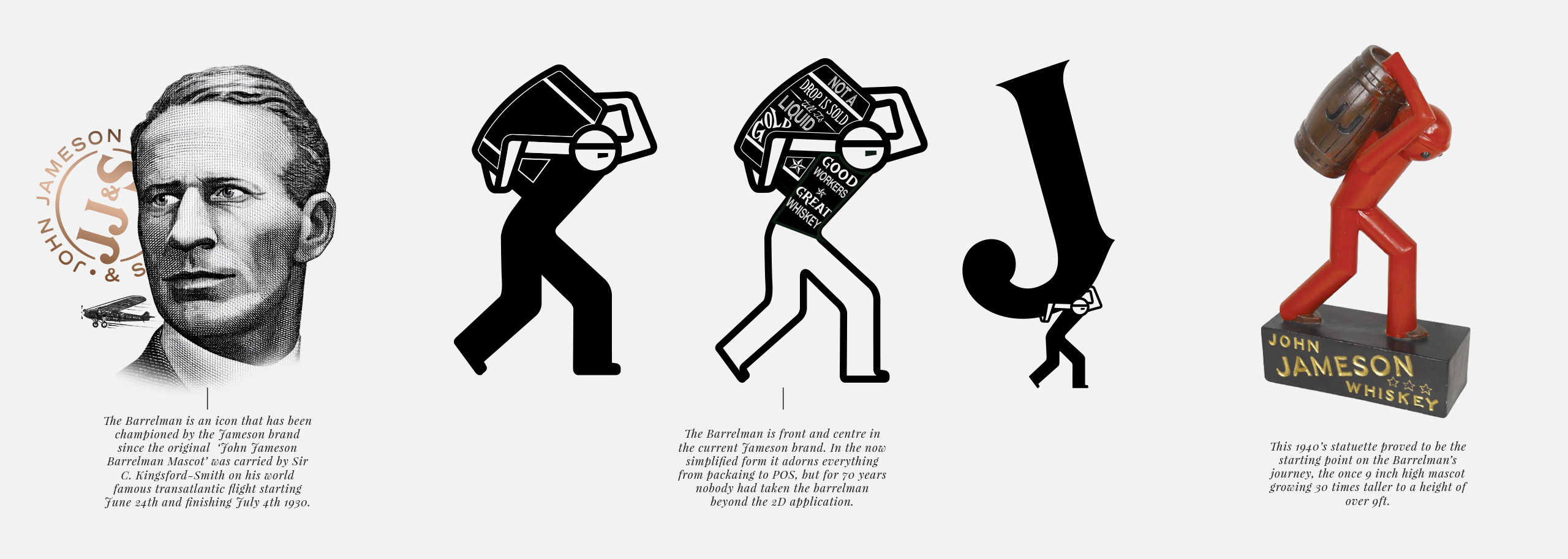
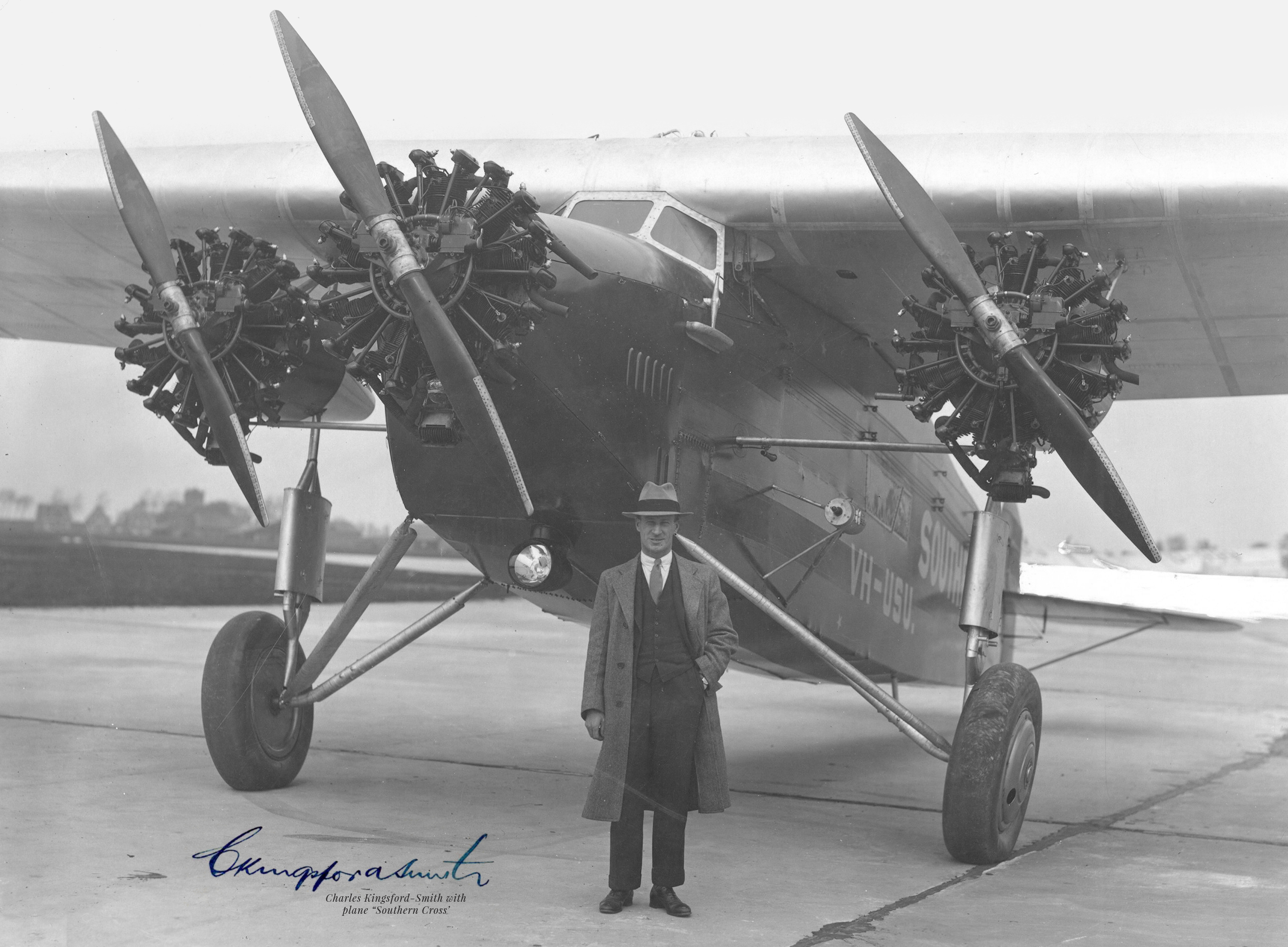
-

 Classic vintage John Jameson's JJ & S Whiskey Mirror Est 1780 in beautiful gilded frame.A real Jameson collectors items and proving harder and harder to acquire.For pricing and shipment quotation please contact us directly at irishpubemporium@gmail.com. 54cm x 40cm. Inchicore Dublin John Jameson was originally a lawyer from Alloa in Scotland before he founded his eponymous distillery in Dublin in 1780.Prevoius to this he had made the wise move of marrying Margaret Haig (1753–1815) in 1768,one of the simple reasons being Margaret was the eldest daughter of John Haig, the famous whisky distiller in Scotland. John and Margaret had eight sons and eight daughters, a family of 16 children. Portraits of the couple by Sir Henry Raeburn are on display in the National Gallery of Ireland. John Jameson joined the Convivial Lodge No. 202, of the Dublin Freemasons on the 24th June 1774 and in 1780, Irish whiskey distillation began at Bow Street. In 1805, he was joined by his son John Jameson II who took over the family business that year and for the next 41 years, John Jameson II built up the business before handing over to his son John Jameson the 3rd in 1851. In 1901, the Company was formally incorporated as John Jameson and Son Ltd. Four of John Jameson’s sons followed his footsteps in distilling in Ireland, John Jameson II (1773 – 1851) at Bow Street, William and James Jameson at Marrowbone Lane in Dublin (where they partnered their Stein relations, calling their business Jameson and Stein, before settling on William Jameson & Co.). The fourth of Jameson's sons, Andrew, who had a small distillery at Enniscorthy, Co. Wexford, was the grandfather of Guglielmo Marconi, inventor of wireless telegraphy. Marconi’s mother was Annie Jameson, Andrew’s daughter. John Jameson’s eldest son, Robert took over his father’s legal business in Alloa. The Jamesons became the most important distilling family in Ireland, despite rivalry between the Bow Street and Marrowbone Lane distilleries. By the turn of the 19th century, it was the second largest producer in Ireland and one of the largest in the world, producing 1,000,000 gallons annually. Dublin at the time was the centre of world whiskey production. It was the second most popular spirit in the world after rum and internationally Jameson had by 1805 become the world's number one whiskey. Today, Jameson is the world's third largest single-distillery whiskey. Historical events, for a time, set the company back. The temperance movement in Ireland had an enormous impact domestically but the two key events that affected Jameson were the Irish War of Independence and subsequent trade war with the British which denied Jameson the export markets of the Commonwealth, and shortly thereafter, the introduction of prohibition in the United States. While Scottish brands could easily slip across the Canada–US border, Jameson was excluded from its biggest market for many years. The introduction of column stills by the Scottish blenders in the mid-19th-century enabled increased production that the Irish, still making labour-intensive single pot still whiskey, could not compete with. There was a legal enquiry somewhere in 1908 to deal with the trade definition of whiskey. The Scottish producers won within some jurisdictions, and blends became recognised in the law of that jurisdiction as whiskey. The Irish in general, and Jameson in particular, continued with the traditional pot still production process for many years.In 1966 John Jameson merged with Cork Distillers and John Powers to form the Irish Distillers Group. In 1976, the Dublin whiskey distilleries of Jameson in Bow Street and in John's Lane were closed following the opening of a New Midleton Distillery by Irish Distillers outside Cork. The Midleton Distillery now produces much of the Irish whiskey sold in Ireland under the Jameson, Midleton, Powers, Redbreast, Spot and Paddy labels. The new facility adjoins the Old Midleton Distillery, the original home of the Paddy label, which is now home to the Jameson Experience Visitor Centre and the Irish Whiskey Academy. The Jameson brand was acquired by the French drinks conglomerate Pernod Ricard in 1988, when it bought Irish Distillers. The old Jameson Distillery in Bow Street near Smithfield in Dublin now serves as a museum which offers tours and tastings. The distillery, which is historical in nature and no longer produces whiskey on site, went through a $12.6 million renovation that was concluded in March 2016, and is now a focal part of Ireland's strategy to raise the number of whiskey tourists, which stood at 600,000 in 2017.Bow Street also now has a fully functioning Maturation Warehouse within its walls since the 2016 renovation. It is here that Jameson 18 Bow Street is finished before being bottled at Cask Strength. In 2008, The Local, an Irish pub in Minneapolis, sold 671 cases of Jameson (22 bottles a day),making it the largest server of Jameson's in the world – a title it maintained for four consecutive years.
Classic vintage John Jameson's JJ & S Whiskey Mirror Est 1780 in beautiful gilded frame.A real Jameson collectors items and proving harder and harder to acquire.For pricing and shipment quotation please contact us directly at irishpubemporium@gmail.com. 54cm x 40cm. Inchicore Dublin John Jameson was originally a lawyer from Alloa in Scotland before he founded his eponymous distillery in Dublin in 1780.Prevoius to this he had made the wise move of marrying Margaret Haig (1753–1815) in 1768,one of the simple reasons being Margaret was the eldest daughter of John Haig, the famous whisky distiller in Scotland. John and Margaret had eight sons and eight daughters, a family of 16 children. Portraits of the couple by Sir Henry Raeburn are on display in the National Gallery of Ireland. John Jameson joined the Convivial Lodge No. 202, of the Dublin Freemasons on the 24th June 1774 and in 1780, Irish whiskey distillation began at Bow Street. In 1805, he was joined by his son John Jameson II who took over the family business that year and for the next 41 years, John Jameson II built up the business before handing over to his son John Jameson the 3rd in 1851. In 1901, the Company was formally incorporated as John Jameson and Son Ltd. Four of John Jameson’s sons followed his footsteps in distilling in Ireland, John Jameson II (1773 – 1851) at Bow Street, William and James Jameson at Marrowbone Lane in Dublin (where they partnered their Stein relations, calling their business Jameson and Stein, before settling on William Jameson & Co.). The fourth of Jameson's sons, Andrew, who had a small distillery at Enniscorthy, Co. Wexford, was the grandfather of Guglielmo Marconi, inventor of wireless telegraphy. Marconi’s mother was Annie Jameson, Andrew’s daughter. John Jameson’s eldest son, Robert took over his father’s legal business in Alloa. The Jamesons became the most important distilling family in Ireland, despite rivalry between the Bow Street and Marrowbone Lane distilleries. By the turn of the 19th century, it was the second largest producer in Ireland and one of the largest in the world, producing 1,000,000 gallons annually. Dublin at the time was the centre of world whiskey production. It was the second most popular spirit in the world after rum and internationally Jameson had by 1805 become the world's number one whiskey. Today, Jameson is the world's third largest single-distillery whiskey. Historical events, for a time, set the company back. The temperance movement in Ireland had an enormous impact domestically but the two key events that affected Jameson were the Irish War of Independence and subsequent trade war with the British which denied Jameson the export markets of the Commonwealth, and shortly thereafter, the introduction of prohibition in the United States. While Scottish brands could easily slip across the Canada–US border, Jameson was excluded from its biggest market for many years. The introduction of column stills by the Scottish blenders in the mid-19th-century enabled increased production that the Irish, still making labour-intensive single pot still whiskey, could not compete with. There was a legal enquiry somewhere in 1908 to deal with the trade definition of whiskey. The Scottish producers won within some jurisdictions, and blends became recognised in the law of that jurisdiction as whiskey. The Irish in general, and Jameson in particular, continued with the traditional pot still production process for many years.In 1966 John Jameson merged with Cork Distillers and John Powers to form the Irish Distillers Group. In 1976, the Dublin whiskey distilleries of Jameson in Bow Street and in John's Lane were closed following the opening of a New Midleton Distillery by Irish Distillers outside Cork. The Midleton Distillery now produces much of the Irish whiskey sold in Ireland under the Jameson, Midleton, Powers, Redbreast, Spot and Paddy labels. The new facility adjoins the Old Midleton Distillery, the original home of the Paddy label, which is now home to the Jameson Experience Visitor Centre and the Irish Whiskey Academy. The Jameson brand was acquired by the French drinks conglomerate Pernod Ricard in 1988, when it bought Irish Distillers. The old Jameson Distillery in Bow Street near Smithfield in Dublin now serves as a museum which offers tours and tastings. The distillery, which is historical in nature and no longer produces whiskey on site, went through a $12.6 million renovation that was concluded in March 2016, and is now a focal part of Ireland's strategy to raise the number of whiskey tourists, which stood at 600,000 in 2017.Bow Street also now has a fully functioning Maturation Warehouse within its walls since the 2016 renovation. It is here that Jameson 18 Bow Street is finished before being bottled at Cask Strength. In 2008, The Local, an Irish pub in Minneapolis, sold 671 cases of Jameson (22 bottles a day),making it the largest server of Jameson's in the world – a title it maintained for four consecutive years. -
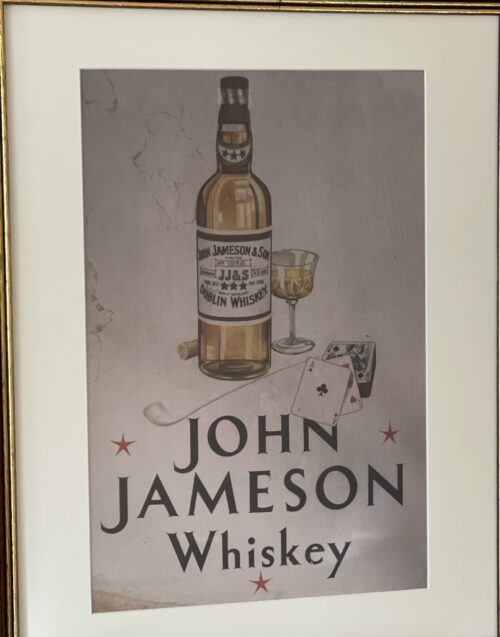
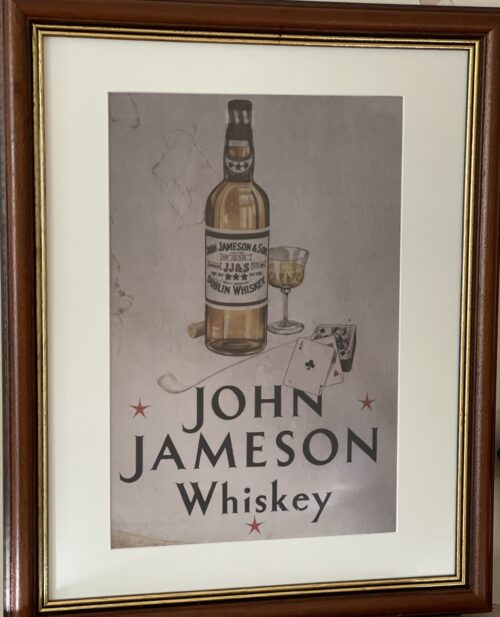 60cm x 50cm Limerick John Jameson was originally a lawyer from Alloa in Scotland before he founded his eponymous distillery in Dublin in 1780.Prevoius to this he had made the wise move of marrying Margaret Haig (1753–1815) in 1768,one of the simple reasons being Margaret was the eldest daughter of John Haig, the famous whisky distiller in Scotland. John and Margaret had eight sons and eight daughters, a family of 16 children. Portraits of the couple by Sir Henry Raeburn are on display in the National Gallery of Ireland. John Jameson joined the Convivial Lodge No. 202, of the Dublin Freemasons on the 24th June 1774 and in 1780, Irish whiskey distillation began at Bow Street. In 1805, he was joined by his son John Jameson II who took over the family business that year and for the next 41 years, John Jameson II built up the business before handing over to his son John Jameson the 3rd in 1851. In 1901, the Company was formally incorporated as John Jameson and Son Ltd. Four of John Jameson’s sons followed his footsteps in distilling in Ireland, John Jameson II (1773 – 1851) at Bow Street, William and James Jameson at Marrowbone Lane in Dublin (where they partnered their Stein relations, calling their business Jameson and Stein, before settling on William Jameson & Co.). The fourth of Jameson's sons, Andrew, who had a small distillery at Enniscorthy, Co. Wexford, was the grandfather of Guglielmo Marconi, inventor of wireless telegraphy. Marconi’s mother was Annie Jameson, Andrew’s daughter. John Jameson’s eldest son, Robert took over his father’s legal business in Alloa. The Jamesons became the most important distilling family in Ireland, despite rivalry between the Bow Street and Marrowbone Lane distilleries. By the turn of the 19th century, it was the second largest producer in Ireland and one of the largest in the world, producing 1,000,000 gallons annually. Dublin at the time was the centre of world whiskey production. It was the second most popular spirit in the world after rum and internationally Jameson had by 1805 become the world's number one whiskey. Today, Jameson is the world's third largest single-distillery whiskey. Historical events, for a time, set the company back. The temperance movement in Ireland had an enormous impact domestically but the two key events that affected Jameson were the Irish War of Independence and subsequent trade war with the British which denied Jameson the export markets of the Commonwealth, and shortly thereafter, the introduction of prohibition in the United States. While Scottish brands could easily slip across the Canada–US border, Jameson was excluded from its biggest market for many years. The introduction of column stills by the Scottish blenders in the mid-19th-century enabled increased production that the Irish, still making labour-intensive single pot still whiskey, could not compete with. There was a legal enquiry somewhere in 1908 to deal with the trade definition of whiskey. The Scottish producers won within some jurisdictions, and blends became recognised in the law of that jurisdiction as whiskey. The Irish in general, and Jameson in particular, continued with the traditional pot still production process for many years.In 1966 John Jameson merged with Cork Distillers and John Powers to form the Irish Distillers Group. In 1976, the Dublin whiskey distilleries of Jameson in Bow Street and in John's Lane were closed following the opening of a New Midleton Distillery by Irish Distillers outside Cork. The Midleton Distillery now produces much of the Irish whiskey sold in Ireland under the Jameson, Midleton, Powers, Redbreast, Spot and Paddy labels. The new facility adjoins the Old Midleton Distillery, the original home of the Paddy label, which is now home to the Jameson Experience Visitor Centre and the Irish Whiskey Academy. The Jameson brand was acquired by the French drinks conglomerate Pernod Ricard in 1988, when it bought Irish Distillers. The old Jameson Distillery in Bow Street near Smithfield in Dublin now serves as a museum which offers tours and tastings. The distillery, which is historical in nature and no longer produces whiskey on site, went through a $12.6 million renovation that was concluded in March 2016, and is now a focal part of Ireland's strategy to raise the number of whiskey tourists, which stood at 600,000 in 2017.Bow Street also now has a fully functioning Maturation Warehouse within its walls since the 2016 renovation. It is here that Jameson 18 Bow Street is finished before being bottled at Cask Strength. In 2008, The Local, an Irish pub in Minneapolis, sold 671 cases of Jameson (22 bottles a day),making it the largest server of Jameson's in the world – a title it maintained for four consecutive years.
60cm x 50cm Limerick John Jameson was originally a lawyer from Alloa in Scotland before he founded his eponymous distillery in Dublin in 1780.Prevoius to this he had made the wise move of marrying Margaret Haig (1753–1815) in 1768,one of the simple reasons being Margaret was the eldest daughter of John Haig, the famous whisky distiller in Scotland. John and Margaret had eight sons and eight daughters, a family of 16 children. Portraits of the couple by Sir Henry Raeburn are on display in the National Gallery of Ireland. John Jameson joined the Convivial Lodge No. 202, of the Dublin Freemasons on the 24th June 1774 and in 1780, Irish whiskey distillation began at Bow Street. In 1805, he was joined by his son John Jameson II who took over the family business that year and for the next 41 years, John Jameson II built up the business before handing over to his son John Jameson the 3rd in 1851. In 1901, the Company was formally incorporated as John Jameson and Son Ltd. Four of John Jameson’s sons followed his footsteps in distilling in Ireland, John Jameson II (1773 – 1851) at Bow Street, William and James Jameson at Marrowbone Lane in Dublin (where they partnered their Stein relations, calling their business Jameson and Stein, before settling on William Jameson & Co.). The fourth of Jameson's sons, Andrew, who had a small distillery at Enniscorthy, Co. Wexford, was the grandfather of Guglielmo Marconi, inventor of wireless telegraphy. Marconi’s mother was Annie Jameson, Andrew’s daughter. John Jameson’s eldest son, Robert took over his father’s legal business in Alloa. The Jamesons became the most important distilling family in Ireland, despite rivalry between the Bow Street and Marrowbone Lane distilleries. By the turn of the 19th century, it was the second largest producer in Ireland and one of the largest in the world, producing 1,000,000 gallons annually. Dublin at the time was the centre of world whiskey production. It was the second most popular spirit in the world after rum and internationally Jameson had by 1805 become the world's number one whiskey. Today, Jameson is the world's third largest single-distillery whiskey. Historical events, for a time, set the company back. The temperance movement in Ireland had an enormous impact domestically but the two key events that affected Jameson were the Irish War of Independence and subsequent trade war with the British which denied Jameson the export markets of the Commonwealth, and shortly thereafter, the introduction of prohibition in the United States. While Scottish brands could easily slip across the Canada–US border, Jameson was excluded from its biggest market for many years. The introduction of column stills by the Scottish blenders in the mid-19th-century enabled increased production that the Irish, still making labour-intensive single pot still whiskey, could not compete with. There was a legal enquiry somewhere in 1908 to deal with the trade definition of whiskey. The Scottish producers won within some jurisdictions, and blends became recognised in the law of that jurisdiction as whiskey. The Irish in general, and Jameson in particular, continued with the traditional pot still production process for many years.In 1966 John Jameson merged with Cork Distillers and John Powers to form the Irish Distillers Group. In 1976, the Dublin whiskey distilleries of Jameson in Bow Street and in John's Lane were closed following the opening of a New Midleton Distillery by Irish Distillers outside Cork. The Midleton Distillery now produces much of the Irish whiskey sold in Ireland under the Jameson, Midleton, Powers, Redbreast, Spot and Paddy labels. The new facility adjoins the Old Midleton Distillery, the original home of the Paddy label, which is now home to the Jameson Experience Visitor Centre and the Irish Whiskey Academy. The Jameson brand was acquired by the French drinks conglomerate Pernod Ricard in 1988, when it bought Irish Distillers. The old Jameson Distillery in Bow Street near Smithfield in Dublin now serves as a museum which offers tours and tastings. The distillery, which is historical in nature and no longer produces whiskey on site, went through a $12.6 million renovation that was concluded in March 2016, and is now a focal part of Ireland's strategy to raise the number of whiskey tourists, which stood at 600,000 in 2017.Bow Street also now has a fully functioning Maturation Warehouse within its walls since the 2016 renovation. It is here that Jameson 18 Bow Street is finished before being bottled at Cask Strength. In 2008, The Local, an Irish pub in Minneapolis, sold 671 cases of Jameson (22 bottles a day),making it the largest server of Jameson's in the world – a title it maintained for four consecutive years. -
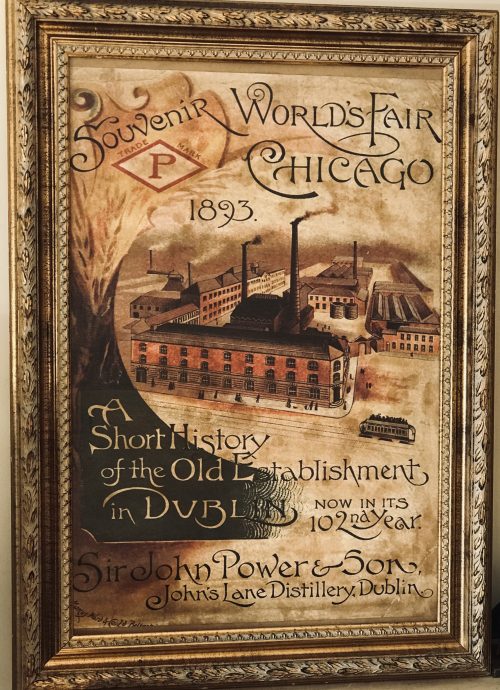 90cm x 65cm Dublin A beautiful original souvenir Powers Whiskey poster advertising the company's participation at the 1893 World Fair held in Chicago to celebrate the 400th anniversary of Christopher Columbus's arrival in the New World in 1492.The fair was an influential social and cultural event and had a profound effect on architecture,sanitation,the Arts,Chicago's self image and American Industrial optimism .Powers Whiskey itself was established in 1792 before moving to Johns Lane in 1822 and then expanding its ranks and production levels rapidly to become one of the most impressive architectural sights in Victorian Dublin-an overhead view of which is depicted in this beautiful print. In 1791 James Power, an innkeeper from Dublin, established a small distillery at his public house at 109 Thomas St., Dublin. The distillery, which had an output of about 6,000 gallons in its first year of operation, initially traded as James Power and Son, but by 1822 had become John Power & Son,and had moved to a new premises at John’s Lane, a side street off Thomas Street. At the time the distillery had three pot stills, though only one, a 500-gallon still is thought to have been in use. Following reform of the distilling laws in 1823, the distillery expanded rapidly. In 1827, production was reported at 160,270 gallons,and by 1833 had grown to 300,000 gallons per annum. As the distillery grew, so too did the stature of the family. In 1841, John Power, grandson of the founder was awarded a baronet, a hereditary title. In 1855, his son Sir James Power, laid the foundation stone for the O’Connell Monument, and in 1859 became High Sheriff of Dublin. In 1871, the distillery was expanded and rebuilt in the Victorian style, becoming one of the most impressive sights in Dublin.After expansion, output at the distillery rose to 700,000 gallons per annum, and by the 1880s, had reached about 900,000 gallons per annum, at which point the distillery covered over six acres of central Dublin, and had a staff of about 300 people.During this period, when the Dublin whiskey distilleries were amongst the largest in the world, the family run firms of John Powers, along with John Jameson, William Jameson, and George Roe, (collectively known as the “Big Four”) came to dominate the Irish distilling landscape, introducing several innovations. In 1886, John Power & Son began bottling their own whiskey, rather than following the practice customary at the time, of selling whiskey directly to merchants and bonders who would bottle it themselves. They were the first Dublin distillery to do so, and one of the first in the world.A gold label adorned each bottle and it was from these that the whiskey got the name Powers Gold Label. When Alfred Barnard, the British historian visited John’s Lane in the late 1880s, he noted the elegance and cleanliness of the buildings, and the modernity of the distillery, describing it as “about as complete a work as it is possible to find anywhere”. At the time of his visit, the distillery was home to five pot stills, two of which with capacities of 25,000 gallons, were amongst the largest ever built.In addition, Barnard was high in his praise for Powers whiskey, noting:”The old make, which we drank with our luncheon was delicious and finer than anything we had hitherto tasted.It was as perfect in flavour, and as pronounced in the ancient aroma of Irish Whiskey so dear to to the hearts of connoisseurs,as one could possibly desire and we found a small flask of it very useful afterwards on our travels.” The last member of the family to sit on the board was Sir Thomas Talbot Power,who died in 1930,and with him the Power’s Baronetcy. However, ownership remained in the family until 1966, and several descendants of his sisters remained at work with the company until recent times. In 1961, a Coffey still was installed in John’s Lane Distillery, allowing the production of vodka and gin, in addition to the testing of grain whiskey for use in blended whiskey. This was a notable departure for the firm, as for many years the big Dublin distilling dynasties had shunned the use of Coffey stills, questioning if their output, grain whiskey could even be termed whiskey. However, with many of the Irish distilleries having closed in the early 20th century in part due to their failure to embrace a change in consumer preference towards blended whiskey, Powers were instrumental in convincing the remaining Irish distilleries to reconsider their stance on blended whiskey. In 1966, with the Irish whiskey industry still struggling following Prohibition in the United States, the Anglo-Irish Trade War and the rise of competition from Scotch whiskey, John Powers & Son joined forces with the only other remaining distillers in the Irish Republic, the Cork Distilleries Company and their Dublin rivals John Jameson & Son, to form Irish Distillers. Soon after, in a bold move, Irish Distillers decided to close all of their existing distilleries, and to consolidate production at a new purpose-built facility in Midleton (the New Midleton Distillery) alongside their existing Old Midleton Distillery. The new distillery opened in 1975, and a year later, production ceased at John’s Lane Distillery and began anew in Cork, with Powers Gold Label and many other Irish whiskeys reformulated from single pot stills whiskeys to blends. In 1989, Irish Distillers itself became a subsidiary of Pernod-Ricard following a friendly takeover.Since the closure of the John’s Lane distillery, many of the distillery buildings were demolished. However, some of the buildings have been incorporated into the National College of Art and Design, and are now protected structures. In addition, three of the distillery’s pot stills were saved and now located in the college’s Red Square.
90cm x 65cm Dublin A beautiful original souvenir Powers Whiskey poster advertising the company's participation at the 1893 World Fair held in Chicago to celebrate the 400th anniversary of Christopher Columbus's arrival in the New World in 1492.The fair was an influential social and cultural event and had a profound effect on architecture,sanitation,the Arts,Chicago's self image and American Industrial optimism .Powers Whiskey itself was established in 1792 before moving to Johns Lane in 1822 and then expanding its ranks and production levels rapidly to become one of the most impressive architectural sights in Victorian Dublin-an overhead view of which is depicted in this beautiful print. In 1791 James Power, an innkeeper from Dublin, established a small distillery at his public house at 109 Thomas St., Dublin. The distillery, which had an output of about 6,000 gallons in its first year of operation, initially traded as James Power and Son, but by 1822 had become John Power & Son,and had moved to a new premises at John’s Lane, a side street off Thomas Street. At the time the distillery had three pot stills, though only one, a 500-gallon still is thought to have been in use. Following reform of the distilling laws in 1823, the distillery expanded rapidly. In 1827, production was reported at 160,270 gallons,and by 1833 had grown to 300,000 gallons per annum. As the distillery grew, so too did the stature of the family. In 1841, John Power, grandson of the founder was awarded a baronet, a hereditary title. In 1855, his son Sir James Power, laid the foundation stone for the O’Connell Monument, and in 1859 became High Sheriff of Dublin. In 1871, the distillery was expanded and rebuilt in the Victorian style, becoming one of the most impressive sights in Dublin.After expansion, output at the distillery rose to 700,000 gallons per annum, and by the 1880s, had reached about 900,000 gallons per annum, at which point the distillery covered over six acres of central Dublin, and had a staff of about 300 people.During this period, when the Dublin whiskey distilleries were amongst the largest in the world, the family run firms of John Powers, along with John Jameson, William Jameson, and George Roe, (collectively known as the “Big Four”) came to dominate the Irish distilling landscape, introducing several innovations. In 1886, John Power & Son began bottling their own whiskey, rather than following the practice customary at the time, of selling whiskey directly to merchants and bonders who would bottle it themselves. They were the first Dublin distillery to do so, and one of the first in the world.A gold label adorned each bottle and it was from these that the whiskey got the name Powers Gold Label. When Alfred Barnard, the British historian visited John’s Lane in the late 1880s, he noted the elegance and cleanliness of the buildings, and the modernity of the distillery, describing it as “about as complete a work as it is possible to find anywhere”. At the time of his visit, the distillery was home to five pot stills, two of which with capacities of 25,000 gallons, were amongst the largest ever built.In addition, Barnard was high in his praise for Powers whiskey, noting:”The old make, which we drank with our luncheon was delicious and finer than anything we had hitherto tasted.It was as perfect in flavour, and as pronounced in the ancient aroma of Irish Whiskey so dear to to the hearts of connoisseurs,as one could possibly desire and we found a small flask of it very useful afterwards on our travels.” The last member of the family to sit on the board was Sir Thomas Talbot Power,who died in 1930,and with him the Power’s Baronetcy. However, ownership remained in the family until 1966, and several descendants of his sisters remained at work with the company until recent times. In 1961, a Coffey still was installed in John’s Lane Distillery, allowing the production of vodka and gin, in addition to the testing of grain whiskey for use in blended whiskey. This was a notable departure for the firm, as for many years the big Dublin distilling dynasties had shunned the use of Coffey stills, questioning if their output, grain whiskey could even be termed whiskey. However, with many of the Irish distilleries having closed in the early 20th century in part due to their failure to embrace a change in consumer preference towards blended whiskey, Powers were instrumental in convincing the remaining Irish distilleries to reconsider their stance on blended whiskey. In 1966, with the Irish whiskey industry still struggling following Prohibition in the United States, the Anglo-Irish Trade War and the rise of competition from Scotch whiskey, John Powers & Son joined forces with the only other remaining distillers in the Irish Republic, the Cork Distilleries Company and their Dublin rivals John Jameson & Son, to form Irish Distillers. Soon after, in a bold move, Irish Distillers decided to close all of their existing distilleries, and to consolidate production at a new purpose-built facility in Midleton (the New Midleton Distillery) alongside their existing Old Midleton Distillery. The new distillery opened in 1975, and a year later, production ceased at John’s Lane Distillery and began anew in Cork, with Powers Gold Label and many other Irish whiskeys reformulated from single pot stills whiskeys to blends. In 1989, Irish Distillers itself became a subsidiary of Pernod-Ricard following a friendly takeover.Since the closure of the John’s Lane distillery, many of the distillery buildings were demolished. However, some of the buildings have been incorporated into the National College of Art and Design, and are now protected structures. In addition, three of the distillery’s pot stills were saved and now located in the college’s Red Square. The Still House at John’s Lane Distillery, as it looked when Alfred Barnard visited in the 1800s.
The Still House at John’s Lane Distillery, as it looked when Alfred Barnard visited in the 1800s.
-
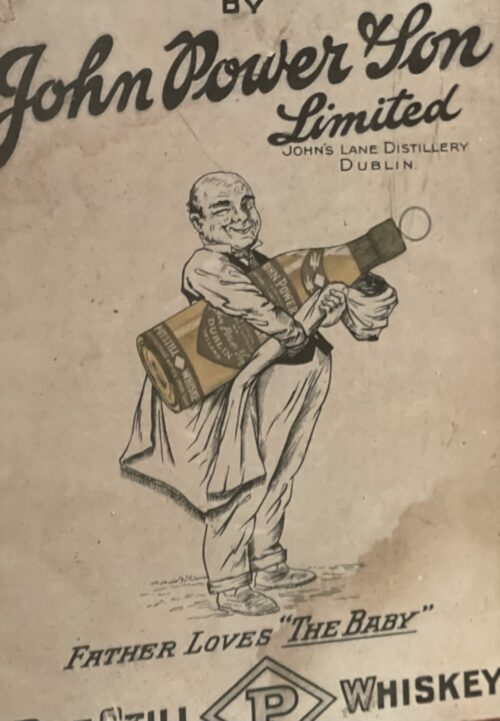
 47cm x 37cm Limerick In 1791 James Power, an innkeeper from Dublin, established a small distillery at his public house at 109 Thomas St., Dublin. The distillery, which had an output of about 6,000 gallons in its first year of operation, initially traded as James Power and Son, but by 1822 had become John Power & Son, and had moved to a new premises at John's Lane, a side street off Thomas Street. At the time the distillery had three pot stills, though only one, a 500-gallon still is thought to have been in use. Following reform of the distilling laws in 1823, the distillery expanded rapidly. In 1827, production was reported at 160,270 gallons,and by 1833 had grown to 300,000 gallons per annum. As the distillery grew, so too did the stature of the family. In 1841, John Power, grandson of the founder was awarded a baronet, a hereditary title. In 1855, his son Sir James Power, laid the foundation stone for the O'Connell Monument, and in 1859 became High Sheriff of Dublin. In 1871, the distillery was expanded and rebuilt in the Victorian style, becoming one of the most impressive sights in Dublin.After expansion, output at the distillery rose to 700,000 gallons per annum, and by the 1880s, had reached about 900,000 gallons per annum, at which point the distillery covered over six acres of central Dublin, and had a staff of about 300 people.During this period, when the Dublin whiskey distilleries were amongst the largest in the world, the family run firms of John Powers, along with John Jameson, William Jameson, and George Roe, (collectively known as the "Big Four") came to dominate the Irish distilling landscape, introducing several innovations. In 1886, John Power & Son began bottling their own whiskey, rather than following the practice customary at the time, of selling whiskey directly to merchants and bonders who would bottle it themselves. They were the first Dublin distillery to do so, and one of the first in the world.A gold label adorned each bottle and it was from these that the whiskey got the name Powers Gold Label. When Alfred Barnard, the British historian visited John's Lane in the late 1880s, he noted the elegance and cleanliness of the buildings, and the modernity of the distillery, describing it as "about as complete a work as it is possible to find anywhere". At the time of his visit, the distillery was home to five pot stills, two of which with capacities of 25,000 gallons, were amongst the largest ever built.In addition, Barnard was high in his praise for Powers whiskey, noting:"The old make, which we drank with our luncheon was delicious and finer than anything we had hitherto tasted.It was as perfect in flavour, and as pronounced in the ancient aroma of Irish Whiskey so dear to to the hearts of connoisseurs,as one could possibly desire and we found a small flask of it very useful afterwards on our travels." The last member of the family to sit on the board was Sir Thomas Talbot Power,who died in 1930,and with him the Power's Baronetcy. However, ownership remained in the family until 1966, and several descendants of his sisters remained at work with the company until recent times. In 1961, a Coffey still was installed in John's Lane Distillery, allowing the production of vodka and gin, in addition to the testing of grain whiskey for use in blended whiskey. This was a notable departure for the firm, as for many years the big Dublin distilling dynasties had shunned the use of Coffey stills, questioning if their output, grain whiskey could even be termed whiskey. However, with many of the Irish distilleries having closed in the early 20th century in part due to their failure to embrace a change in consumer preference towards blended whiskey, Powers were instrumental in convincing the remaining Irish distilleries to reconsider their stance on blended whiskey. In 1966, with the Irish whiskey industry still struggling following Prohibition in the United States, the Anglo-Irish Trade War and the rise of competition from Scotch whiskey, John Powers & Son joined forces with the only other remaining distillers in the Irish Republic, the Cork Distilleries Company and their Dublin rivals John Jameson & Son, to form Irish Distillers. Soon after, in a bold move, Irish Distillers decided to close all of their existing distilleries, and to consolidate production at a new purpose-built facility in Midleton (the New Midleton Distillery) alongside their existing Old Midleton Distillery. The new distillery opened in 1975, and a year later, production ceased at John's Lane Distillery and began anew in Cork, with Powers Gold Label and many other Irish whiskeys reformulated from single pot stills whiskeys to blends. In 1989, Irish Distillers itself became a subsidiary of Pernod-Ricard following a friendly takeover.Since the closure of the John's Lane distillery, many of the distillery buildings were demolished. However, some of the buildings have been incorporated into the National College of Art and Design, and are now protected structures. In addition, three of the distillery's pot stills were saved and now located in the college's Red Square.
47cm x 37cm Limerick In 1791 James Power, an innkeeper from Dublin, established a small distillery at his public house at 109 Thomas St., Dublin. The distillery, which had an output of about 6,000 gallons in its first year of operation, initially traded as James Power and Son, but by 1822 had become John Power & Son, and had moved to a new premises at John's Lane, a side street off Thomas Street. At the time the distillery had three pot stills, though only one, a 500-gallon still is thought to have been in use. Following reform of the distilling laws in 1823, the distillery expanded rapidly. In 1827, production was reported at 160,270 gallons,and by 1833 had grown to 300,000 gallons per annum. As the distillery grew, so too did the stature of the family. In 1841, John Power, grandson of the founder was awarded a baronet, a hereditary title. In 1855, his son Sir James Power, laid the foundation stone for the O'Connell Monument, and in 1859 became High Sheriff of Dublin. In 1871, the distillery was expanded and rebuilt in the Victorian style, becoming one of the most impressive sights in Dublin.After expansion, output at the distillery rose to 700,000 gallons per annum, and by the 1880s, had reached about 900,000 gallons per annum, at which point the distillery covered over six acres of central Dublin, and had a staff of about 300 people.During this period, when the Dublin whiskey distilleries were amongst the largest in the world, the family run firms of John Powers, along with John Jameson, William Jameson, and George Roe, (collectively known as the "Big Four") came to dominate the Irish distilling landscape, introducing several innovations. In 1886, John Power & Son began bottling their own whiskey, rather than following the practice customary at the time, of selling whiskey directly to merchants and bonders who would bottle it themselves. They were the first Dublin distillery to do so, and one of the first in the world.A gold label adorned each bottle and it was from these that the whiskey got the name Powers Gold Label. When Alfred Barnard, the British historian visited John's Lane in the late 1880s, he noted the elegance and cleanliness of the buildings, and the modernity of the distillery, describing it as "about as complete a work as it is possible to find anywhere". At the time of his visit, the distillery was home to five pot stills, two of which with capacities of 25,000 gallons, were amongst the largest ever built.In addition, Barnard was high in his praise for Powers whiskey, noting:"The old make, which we drank with our luncheon was delicious and finer than anything we had hitherto tasted.It was as perfect in flavour, and as pronounced in the ancient aroma of Irish Whiskey so dear to to the hearts of connoisseurs,as one could possibly desire and we found a small flask of it very useful afterwards on our travels." The last member of the family to sit on the board was Sir Thomas Talbot Power,who died in 1930,and with him the Power's Baronetcy. However, ownership remained in the family until 1966, and several descendants of his sisters remained at work with the company until recent times. In 1961, a Coffey still was installed in John's Lane Distillery, allowing the production of vodka and gin, in addition to the testing of grain whiskey for use in blended whiskey. This was a notable departure for the firm, as for many years the big Dublin distilling dynasties had shunned the use of Coffey stills, questioning if their output, grain whiskey could even be termed whiskey. However, with many of the Irish distilleries having closed in the early 20th century in part due to their failure to embrace a change in consumer preference towards blended whiskey, Powers were instrumental in convincing the remaining Irish distilleries to reconsider their stance on blended whiskey. In 1966, with the Irish whiskey industry still struggling following Prohibition in the United States, the Anglo-Irish Trade War and the rise of competition from Scotch whiskey, John Powers & Son joined forces with the only other remaining distillers in the Irish Republic, the Cork Distilleries Company and their Dublin rivals John Jameson & Son, to form Irish Distillers. Soon after, in a bold move, Irish Distillers decided to close all of their existing distilleries, and to consolidate production at a new purpose-built facility in Midleton (the New Midleton Distillery) alongside their existing Old Midleton Distillery. The new distillery opened in 1975, and a year later, production ceased at John's Lane Distillery and began anew in Cork, with Powers Gold Label and many other Irish whiskeys reformulated from single pot stills whiskeys to blends. In 1989, Irish Distillers itself became a subsidiary of Pernod-Ricard following a friendly takeover.Since the closure of the John's Lane distillery, many of the distillery buildings were demolished. However, some of the buildings have been incorporated into the National College of Art and Design, and are now protected structures. In addition, three of the distillery's pot stills were saved and now located in the college's Red Square. The Still House at John's Lane Distillery, as it looked when Alfred Barnard visited in the 1800s.
The Still House at John's Lane Distillery, as it looked when Alfred Barnard visited in the 1800s.
-
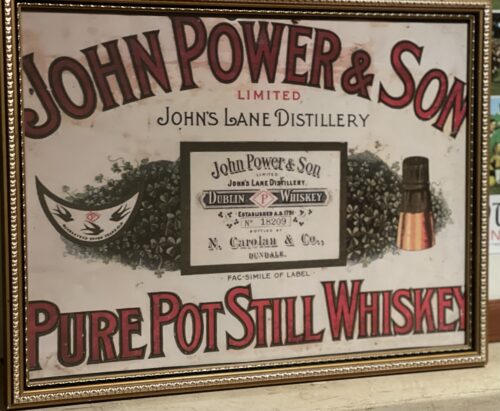
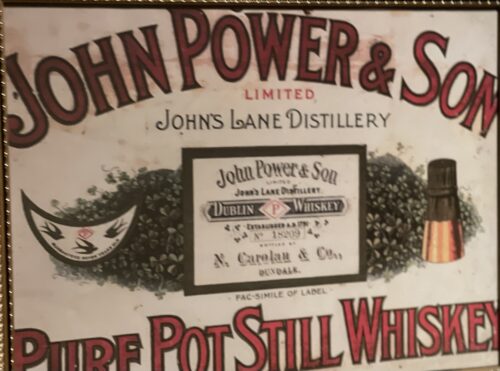 44cm x 33cm Limerick In 1791 James Power, an innkeeper from Dublin, established a small distillery at his public house at 109 Thomas St., Dublin. The distillery, which had an output of about 6,000 gallons in its first year of operation, initially traded as James Power and Son, but by 1822 had become John Power & Son, and had moved to a new premises at John's Lane, a side street off Thomas Street. At the time the distillery had three pot stills, though only one, a 500-gallon still is thought to have been in use. Following reform of the distilling laws in 1823, the distillery expanded rapidly. In 1827, production was reported at 160,270 gallons,and by 1833 had grown to 300,000 gallons per annum. As the distillery grew, so too did the stature of the family. In 1841, John Power, grandson of the founder was awarded a baronet, a hereditary title. In 1855, his son Sir James Power, laid the foundation stone for the O'Connell Monument, and in 1859 became High Sheriff of Dublin. In 1871, the distillery was expanded and rebuilt in the Victorian style, becoming one of the most impressive sights in Dublin.After expansion, output at the distillery rose to 700,000 gallons per annum, and by the 1880s, had reached about 900,000 gallons per annum, at which point the distillery covered over six acres of central Dublin, and had a staff of about 300 people.During this period, when the Dublin whiskey distilleries were amongst the largest in the world, the family run firms of John Powers, along with John Jameson, William Jameson, and George Roe, (collectively known as the "Big Four") came to dominate the Irish distilling landscape, introducing several innovations. In 1886, John Power & Son began bottling their own whiskey, rather than following the practice customary at the time, of selling whiskey directly to merchants and bonders who would bottle it themselves. They were the first Dublin distillery to do so, and one of the first in the world.A gold label adorned each bottle and it was from these that the whiskey got the name Powers Gold Label. When Alfred Barnard, the British historian visited John's Lane in the late 1880s, he noted the elegance and cleanliness of the buildings, and the modernity of the distillery, describing it as "about as complete a work as it is possible to find anywhere". At the time of his visit, the distillery was home to five pot stills, two of which with capacities of 25,000 gallons, were amongst the largest ever built.In addition, Barnard was high in his praise for Powers whiskey, noting:"The old make, which we drank with our luncheon was delicious and finer than anything we had hitherto tasted.It was as perfect in flavour, and as pronounced in the ancient aroma of Irish Whiskey so dear to to the hearts of connoisseurs,as one could possibly desire and we found a small flask of it very useful afterwards on our travels." The last member of the family to sit on the board was Sir Thomas Talbot Power,who died in 1930,and with him the Power's Baronetcy. However, ownership remained in the family until 1966, and several descendants of his sisters remained at work with the company until recent times. In 1961, a Coffey still was installed in John's Lane Distillery, allowing the production of vodka and gin, in addition to the testing of grain whiskey for use in blended whiskey. This was a notable departure for the firm, as for many years the big Dublin distilling dynasties had shunned the use of Coffey stills, questioning if their output, grain whiskey could even be termed whiskey. However, with many of the Irish distilleries having closed in the early 20th century in part due to their failure to embrace a change in consumer preference towards blended whiskey, Powers were instrumental in convincing the remaining Irish distilleries to reconsider their stance on blended whiskey. In 1966, with the Irish whiskey industry still struggling following Prohibition in the United States, the Anglo-Irish Trade War and the rise of competition from Scotch whiskey, John Powers & Son joined forces with the only other remaining distillers in the Irish Republic, the Cork Distilleries Company and their Dublin rivals John Jameson & Son, to form Irish Distillers. Soon after, in a bold move, Irish Distillers decided to close all of their existing distilleries, and to consolidate production at a new purpose-built facility in Midleton (the New Midleton Distillery) alongside their existing Old Midleton Distillery. The new distillery opened in 1975, and a year later, production ceased at John's Lane Distillery and began anew in Cork, with Powers Gold Label and many other Irish whiskeys reformulated from single pot stills whiskeys to blends. In 1989, Irish Distillers itself became a subsidiary of Pernod-Ricard following a friendly takeover.Since the closure of the John's Lane distillery, many of the distillery buildings were demolished. However, some of the buildings have been incorporated into the National College of Art and Design, and are now protected structures. In addition, three of the distillery's pot stills were saved and now located in the college's Red Square.
44cm x 33cm Limerick In 1791 James Power, an innkeeper from Dublin, established a small distillery at his public house at 109 Thomas St., Dublin. The distillery, which had an output of about 6,000 gallons in its first year of operation, initially traded as James Power and Son, but by 1822 had become John Power & Son, and had moved to a new premises at John's Lane, a side street off Thomas Street. At the time the distillery had three pot stills, though only one, a 500-gallon still is thought to have been in use. Following reform of the distilling laws in 1823, the distillery expanded rapidly. In 1827, production was reported at 160,270 gallons,and by 1833 had grown to 300,000 gallons per annum. As the distillery grew, so too did the stature of the family. In 1841, John Power, grandson of the founder was awarded a baronet, a hereditary title. In 1855, his son Sir James Power, laid the foundation stone for the O'Connell Monument, and in 1859 became High Sheriff of Dublin. In 1871, the distillery was expanded and rebuilt in the Victorian style, becoming one of the most impressive sights in Dublin.After expansion, output at the distillery rose to 700,000 gallons per annum, and by the 1880s, had reached about 900,000 gallons per annum, at which point the distillery covered over six acres of central Dublin, and had a staff of about 300 people.During this period, when the Dublin whiskey distilleries were amongst the largest in the world, the family run firms of John Powers, along with John Jameson, William Jameson, and George Roe, (collectively known as the "Big Four") came to dominate the Irish distilling landscape, introducing several innovations. In 1886, John Power & Son began bottling their own whiskey, rather than following the practice customary at the time, of selling whiskey directly to merchants and bonders who would bottle it themselves. They were the first Dublin distillery to do so, and one of the first in the world.A gold label adorned each bottle and it was from these that the whiskey got the name Powers Gold Label. When Alfred Barnard, the British historian visited John's Lane in the late 1880s, he noted the elegance and cleanliness of the buildings, and the modernity of the distillery, describing it as "about as complete a work as it is possible to find anywhere". At the time of his visit, the distillery was home to five pot stills, two of which with capacities of 25,000 gallons, were amongst the largest ever built.In addition, Barnard was high in his praise for Powers whiskey, noting:"The old make, which we drank with our luncheon was delicious and finer than anything we had hitherto tasted.It was as perfect in flavour, and as pronounced in the ancient aroma of Irish Whiskey so dear to to the hearts of connoisseurs,as one could possibly desire and we found a small flask of it very useful afterwards on our travels." The last member of the family to sit on the board was Sir Thomas Talbot Power,who died in 1930,and with him the Power's Baronetcy. However, ownership remained in the family until 1966, and several descendants of his sisters remained at work with the company until recent times. In 1961, a Coffey still was installed in John's Lane Distillery, allowing the production of vodka and gin, in addition to the testing of grain whiskey for use in blended whiskey. This was a notable departure for the firm, as for many years the big Dublin distilling dynasties had shunned the use of Coffey stills, questioning if their output, grain whiskey could even be termed whiskey. However, with many of the Irish distilleries having closed in the early 20th century in part due to their failure to embrace a change in consumer preference towards blended whiskey, Powers were instrumental in convincing the remaining Irish distilleries to reconsider their stance on blended whiskey. In 1966, with the Irish whiskey industry still struggling following Prohibition in the United States, the Anglo-Irish Trade War and the rise of competition from Scotch whiskey, John Powers & Son joined forces with the only other remaining distillers in the Irish Republic, the Cork Distilleries Company and their Dublin rivals John Jameson & Son, to form Irish Distillers. Soon after, in a bold move, Irish Distillers decided to close all of their existing distilleries, and to consolidate production at a new purpose-built facility in Midleton (the New Midleton Distillery) alongside their existing Old Midleton Distillery. The new distillery opened in 1975, and a year later, production ceased at John's Lane Distillery and began anew in Cork, with Powers Gold Label and many other Irish whiskeys reformulated from single pot stills whiskeys to blends. In 1989, Irish Distillers itself became a subsidiary of Pernod-Ricard following a friendly takeover.Since the closure of the John's Lane distillery, many of the distillery buildings were demolished. However, some of the buildings have been incorporated into the National College of Art and Design, and are now protected structures. In addition, three of the distillery's pot stills were saved and now located in the college's Red Square. The Still House at John's Lane Distillery, as it looked when Alfred Barnard visited in the 1800s.
The Still House at John's Lane Distillery, as it looked when Alfred Barnard visited in the 1800s.

